1 - Chronological Review of Historic and Classic Cars at 2020 Retromobile |
1891 Back to back seating steam powered vehicle- Exhibit : National Automobile Museum Compiegne
|
| The story of horseless carriages started with three different propulsion systems. There was the steam power, the electric power and the hydrocarbon internal combustion engine. The steam power started with providing static power requirements then later moved trains, ships and automobiles. For the automobile, like the one illustrated there is a heavy boiler in front requiring combustible and water while occupants would sit at the back. The steam power is still in use today for example for generating electricity. The steam car was superseeded by the hydrocarbon internal combustion engines in particular because the petroleum company established a wide infrastructure for distribution of fuel. |
|
1897 Prasident 2.7 Litre Flat 2 cylinder De Dion engine-Exhibit Saga Tatra
|
The 1897 Prasident is considered as one of the first Tatra produced. It was powered by a twin cylinder Benz engine replaced later by a locally produced internal combustion engine.
|
|
| |
1900 Lohner Porsche electric vehicle with range extender-Exhibit Porsche
|
The name Porsche has been associated with pioneering automotive engineering innovations since the beginning of the last century. In 1900 Prof. Ferdinand Porsche unveiled his Lohner Porsche, an electric car with wheel-hub motors driving the front wheels. Soon after, this car featured all-wheel drive and four-wheel brakes, another world first. A highlight of his early years as an automotive designer was the Lohner-Porsche Semper Vivus that went down in history 111 years ago as the first functional hybrid car.
Engine:2x Single cylinder De-Dion-Bouton
combustion engine
Output:2.5 hp (1.85 kW) per cylinder
Electric motor output: 2.7 hp (2 kW) per wheel
Top speed:35 km/h (22 mph)
Range: 200 km (124 miles) |
|
| |
1908 KRIEGER Electric Limousine - Exhibit FFVE
|
Louis Krieger was an engineer in favor of electric drive for automobiles. In 1895, he participated with Charles Jeantaud in the Paris-Bordeaux-Paris race with Jeantaud electric car. Louis Krieger produced electric cars till 1909 when a total of 70 cars had been produced. It is possible to see on the photos the electric motor mounted next to each front wheel. |
|
| |
1910 A.L.F.A. 24 HP -110 Years for Alfa Romeo- Exhibit FCA Heritage
|
The 24 HP is the first car manufactured by the Anonima Lombarda Fabbrica Automobili, whose name was shortend in the acronym ALFA. The model displayed here features torpedo bodywork created by Ercole Castagna which begun a long fruitful collaboration between his renowned atelier and Alfa Romeo. By 1913, approximately 200 chassis had been produced.
The ALFA 24 HP model was positioned at the medium high end of the car market of the time with its traditional layout characterized by cutting edge elements. The engine is afour cylinder in line 4082 cc producing 42 hp at 2400 rpm. Maximum speed is claimed at 100 kph (62 mph). Weight is announced at 870 kg. |
| |
|
|
|
| |
1910 Renault Type BY- 4.396 cc four cylinder engine-1.760 kg - Renault Classic Exhibit |
| The Renault Type BY was introduced in 1909 as a luxury limousine allowing long distance touring for the time. It was propelled by 4.396 cc four cylinder engine linked with a three-speed manual transmission. The car was equiped with a pneumatic engine starter. There was an instrument panel also in the passenger's cabin, allowing to be constantly informed on the running conditions. The empty car weighed 1760 kg. |
|
|
| |
1911 Rolls Royce London Edimburg Experimental Car-Exhibit Lukas Huni
|
The Rolls Royce 40-50 was produced at 7874 examples between 1906 and 1926.
The car at first had a new side-valve, six-cylinder, 7036 cc engine (7428 cc from 1910) with the cylinders cast in two units of three cylinders each as opposed to the triple two-cylinder units on the earlier six. A three-speed transmission was fitted at first with four-speed units used from 1913. The seven-bearing crankshaft had full pressure lubrication, and the centre main bearing was made especially large to remove vibration, essentially splitting the engine into two three-cylinder units. Two spark plugs were fitted to each cylinder with, from 1921, a choice of magneto or coil ignition. The earliest cars had used a trembler coil to produce the spark with a magneto as an optional extra which soon became standard - the instruction was to start the engine on the trembler/battery and then switch to magneto. Continuous development allowed power output to be increased from 48 bhp (36 kW) at 1,250 rpm to 80 bhp (60 kW) at 2,250 rpm. (source Wikipedia) |
|
1912 Nicola Romes reconstruction - 17 Litres six cylinder - Exhibit Estabelecimento Pur Sang Argentina
|
|
|
| |
1912 Rolls Royce Torpedo R 2121 - - Exhibit Lukas Huni
|
The Rolls Royce 40-50 was produced at 7874 examples between 1906 and 1926.
The car at first had a new side-valve, six-cylinder, 7036 cc engine (7428 cc from 1910) with the cylinders cast in two units of three cylinders each as opposed to the triple two-cylinder units on the earlier six. A three-speed transmission was fitted at first with four-speed units used from 1913. The seven-bearing crankshaft had full pressure lubrication, and the centre main bearing was made especially large to remove vibration, essentially splitting the engine into two three-cylinder units. Two spark plugs were fitted to each cylinder with, from 1921, a choice of magneto or coil ignition. The earliest cars had used a trembler coil to produce the spark with a magneto as an optional extra which soon became standard - the instruction was to start the engine on the trembler/battery and then switch to magneto. Continuous development allowed power output to be increased from 48 bhp (36 kW) at 1,250 rpm to 80 bhp (60 kW) at 2,250 rpm. source Wikipedia) |
|
| |
1917 Packard Twin Six Roadster - Exhibit : ORSENAT Auction
|
Packard set up shop in his electrical engineering factory in Warren, Ohio, from which the first Packard car - the single-cylinder Model A runabout - emerged in November 1899.
Cars powered by two-, four- and six-cylinder engines quickly followed, before Packard became the first manufacturer to introduce a series production V12 with the launch of the Twin Six for 1916. Competitively priced at just $2,600 when launched in 1915, the Twin Six would turn out to be an immense success for the company, with in excess of 35,000 sold by the time production ceased in 1923. Powered by a 7.0-litre 60° V12 engine producing it maximum of 88bhp at a lowly 2,600 revs, it was available in two wheelbase lengths: 125" and 135", and was notable for its ability to accelerate from walking pace to a top speed of 70mph in top gear. (source Bonhams 2019) |
|
| |
1920 Bugatti Type 22 Brescia 16 Valve Torpedo Sport- Exhibit Lukas Huni
|
The DNA of the thoroughbred Bugatti was dominant from the very beginning. Ettore'devotion to 'qualité et la belle mécanique' was revealed fully in his 16 valve car- or Brescia as it became known after 1921 due to its racing success in the 1921 Gran Premio d'Italia Voiturette at Brescia Italy- finishing with an impressive 1-2-3-4 result. It was to be the firm foundation upon which the Bugatti marque would flourish. The Brescia was an incredible little car, praised by the motoring press as having "unsurpassed road holding, confort and modern-sounding "firecracker" exhaust note "for which the marque was soon to become famous". The design concept was based on the late 8 valve models, th 16 valve models started to appear in 1920, and Brescia production ran through 1926 to a total of over 2000 cars produced. The carburettor was Zenith, the magneto ignition was either SEV or Bosch units. A pear-shaped radiator adorned the early 16 valve models. A 4-speed transmission formed part of the standard specification. Performance with an easy cruising speed of 60 mph was impressive, and the Brescia easily beat its competitors which featured much larger engines.
see Bugatti Type 13 Brescia 1914, 1919-1926
|
|
| |
1925 Bentley 3 Litre Speed Model Vanden Plas Open Tourer - FISKENS |
The 3 Litre was W.O. Bentley's automotive mantra come to life. Winning countless races, including 24 Hours of Le Mans twice, this model came to epitomise the sporting excellence demostrated by Bentley both on and odd the track.
Built in 1925, this 3 Litre is an outstandingly original example, 1195 is the first of only three production 3 Litre to be fitted with the Le Mans style blade wings, and as such was displayed on the Bentley Motors stand at the 1925 Olympia Motor Show.
see Bentley 3 Litre 1921 1927 Le Mans winner 1924 1927 |
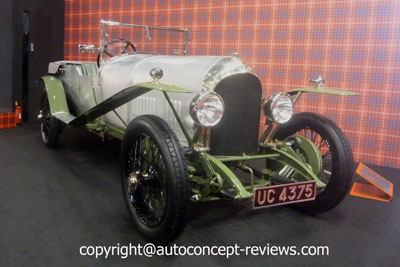 |
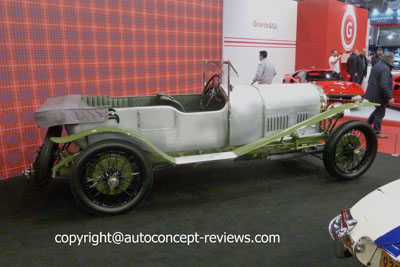 |
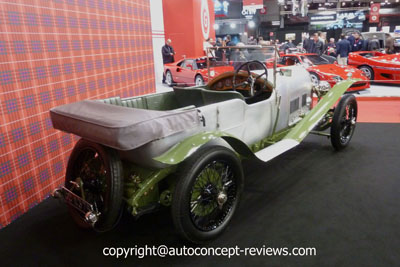 |
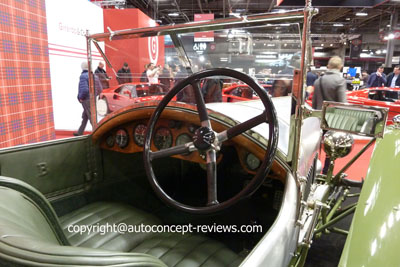 |
|
1928 Alfa Romeo 6C 1500 Super Sport - Exhibit FCA Heritage |
The Alfa Romeo 6C 1500 Sport was created in 1928 designed for racing. It was, however, the Spidezr versions mostly built by Zagato, Castagna and Touring, that captured the interest of gentlemen drivers for racing use. These kightweight agile and responsive cars were characterized by the mechanical perfection of the multi-cylindered engineering jewel hidden under its long bonnet. Only 31 Super Sport and Mille Miglia Speciale versions of the Alfa Romeo 6C 1500 were produced in 1928 and 1929.
Engine 1487 cc 6 cylinder in line producing 76 hp at 4800 rpm. Top speed announced for 140 kph. |
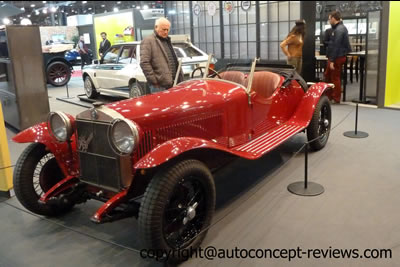 |
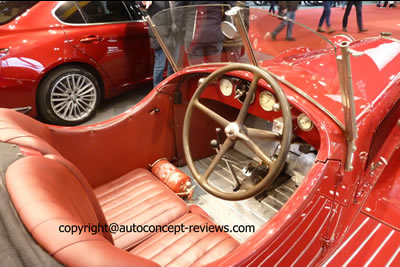 |
|
|
| |
1928 Mercedes Benz Type SSK Rennsportwagen - Movendi |
It was the outstanding popularity of hill-climb events in Europe that lead directly to the development of the most legendary pre-war sports racing car built by Mercedes-Benz – the SSK. It began with the chassis of the Type S, and the engine from the new SS, the company’s top of the line chassis, but the wheelbase was reduced to 116.1in. The chassis – already low – was lowered even further by mounting the rear axle above the springs rather than below. New Houdaille shock absorbers were fitted with fins for improved heat dissipation.
A racing camshaft with higher lift and longer duration, and a new 10psi ‘elephant’ blower increased engine output – with blower operating – to 225 bhp. Even naturally-aspirated output was impressive, at 170 bhp. Later, increased compression and a higher output 12psi ‘elephant’ blower would raise peak horsepower to more than 300 bhp – a staggering figure at the time, and impressive even today.The first outing for the new car came on 28 July 1928, when this Teutonic apparition thundered up Gabelbach hill, setting a new record time, with a charismatic Rudolf Caracciola at the wheel.
More successes followed, and the factory was persuaded to begin production. Within the next year, 33 cars were built .
In 2007, one 1928 Mercedes Benz SSK Roadster was sold for £ 1.210.000 at London RM Auction (source RM 2007)
see Mercedes Benz Super Sport Kurz - SSK - 1928 |
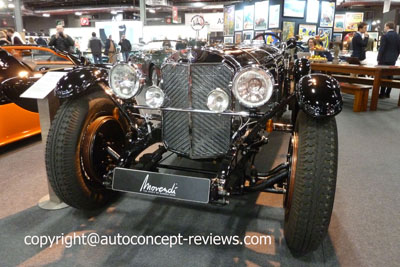 |
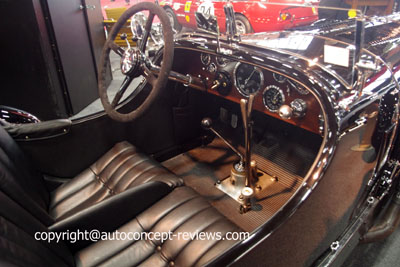 |
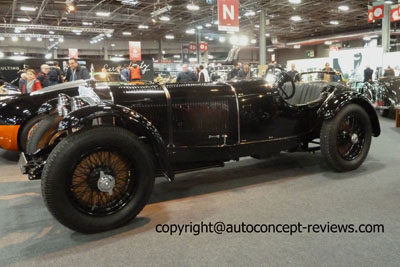 |
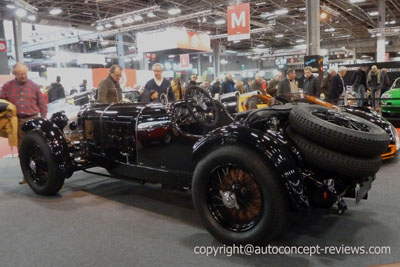 |
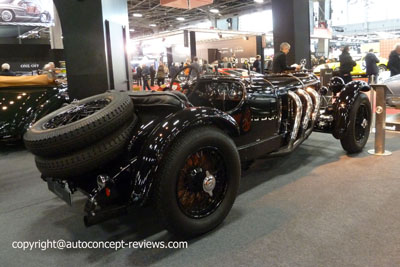 |
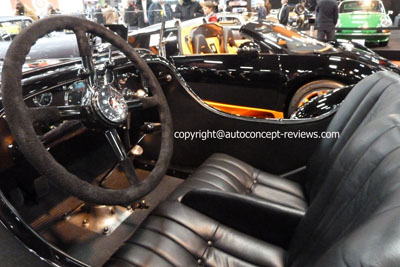 |
|
1929 Bugatti 35C- Bugatti Exhibit
|
The Bugatti Type 35 was first introduced at the 1924 French Grand Prix in Lyon. Five automobiles were entered in the race and only two finished. There were serious problems with the new tires loosing thread.
The Bugatti Type 35, however, soon became one of the most successful racing car of its time. It was also proposed in road use trim with cycle fenders and lamps.
It was a brand new car eventhough many technical solutions were evolution of existing Bugatti techniques.
see Bugatti Type 35 and derivatives Type 37, 39 and 51 1924 1931 |
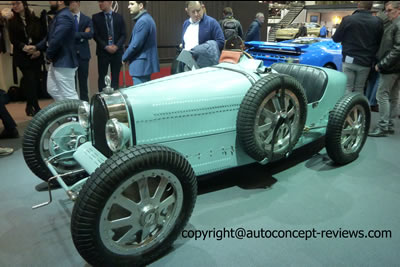 |
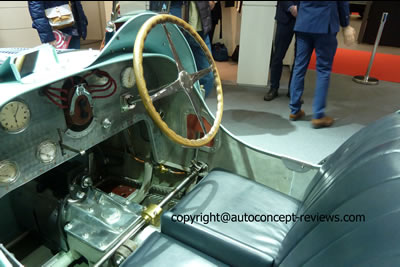 |
|
| |
1931 Aston Martin Team Car LM7 - KIDSTON
|
This Aston Martin 1931 is one of the three Aston Martin factory Team cars and a veteran of the 1931 and 1933 Le Mans 24 Hours event.
By 1931, Aston Martin was already familiar with the "feast and famine" cycle that the marque would experience over the coming century. Four years after purchasing the bankrupt company for £10,000 - just over £410,000 today- A.C.Bertelli found himself without financial backing, having seen several of his partners come and go due to a lack of commercial success.
Part of the financial problem was Bertelli's insistence on racing; altough good as a means of development, the initial team cars -LM1, LM2, LM3 ..LM6, LM7 -had only a few class wins under their belts and had not competed outside of the British Isles since retiring at 24 Hours of Le Mans in 1928.
In 1931, LM7 was entered in the following races as a Team Car: Brooklands Double Twelve (Benjafield, Cook), Le Mans 24 Hours (Cook,Brezzant) ; Ards Royal Automobile Club Tourist Trophy (Cook). |
 |
 |
 |
 |
|
| |
1931 Bugatti Type 56 electric car- FFVE
|
| |
| This fully electric Bugatti Type 56 was designed by Ettore Bugatti for his own use around the factory. It uses an electric motor Scintilla that was the starter motor for the Bugatti Royale and one of the unit used in the Bugatti autorail. The electricity was supplied by six 6 volt batteries. The car weighed 350 kg and was capable of 2 hours of use at full charge with a top speed of 30 kph. The car was equiped with a wooden triangulated chassis a wood floor and simple metal two seats coachwork including a soft hood. The overall dimensions are lenght 2,15 m, width 1,42 m height including hood 1,67 m wheelbase 1,46 m. The car equipped with tires was exhibited at the 1931 Paris Auto Show. |
|
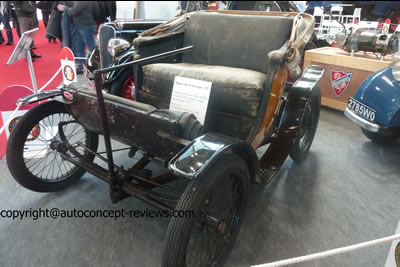 |
|
|
| |
1931 Bentley 4.5 Litre Sportmans Coupe Maythorns of Biggleswade Coachwork - Fiskens |
This is one of the last Bentley 4,5 Litre produced. Following the roaring Le Mans successes of the 3 Litre, W.O. was bitterly disappointed by consecutive Bentley failures at the 1925 and 1926 races. Bentley's reputation had been built on the endurance track, and it was slowly slipping away. Enter the Bentley Boys and the 4,5 Litre. Employing the chassis, transmission and brakes of the 3 Litre, W.O. then added a four cylinder version of the 6,5 Litre to reduce displacement to 4,4 Litre.
With Bentleys nicknamed the world's fastest lorries by a seething Ettore Bugatti, thr thundering 4 cylinder model duly regained victory at Le Mans in 1928 and paved the way for Bentley wins in 1929 and 1930.
This rare Maythorns of Biggleswade Sportsman Coupé Coachwork has been used regularly during 60 years. |
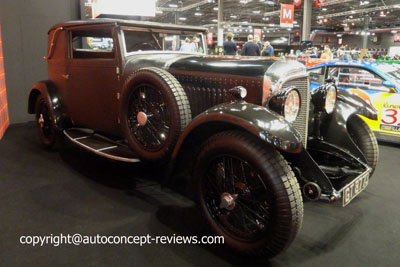 |
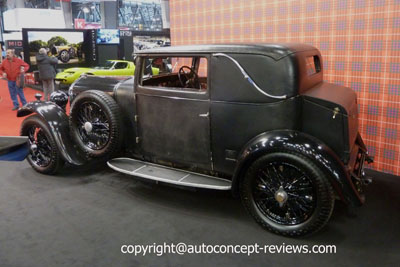 |
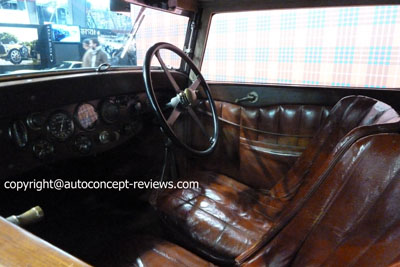 |
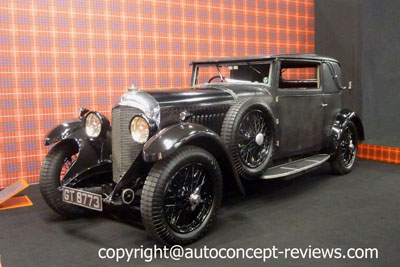 |
|
| |
1932 Alfa Romeo Tipo B (P3) First Series 5006 - Lukas Huni |
|
| |
1933 Alfa Romeo 8C2300 Spider by Touring - Lukas Huni Exhibit |
Vittorio Jano was one of the greatest competition car designers of all times. Initiallyjoining Alfa Romeo from Fiat in 1923, Vittorio Jano was responsible for all Alfa Romeo Grand Prix cars from 1924-1937 (the P2 in 1924 which won the 1925 world championship, the Tipo B called P3, the 8C-35 and the 12C-36), as well as for the Lancia Aurelia, the D23/D24 sports racing and the D50 Grand Prix cars afterWW2. At the same time Jano designed a succession of touting and sports cars, culminating in the 8C2300 which featured the 2336 cc8 cylinder superchargedengine from the Monza racing cars. The competition record of the 8C2300 was outstanding with wins at the 24 Hours of Le Mans consecutively in 1931, 1932, 1933 and 1934, the Mille Miglia in 1932, 1933 and 1934, and many more victories on allthe famous circuits in the world. The 8C2300 is rated by many to be the greatestsports and racing car of all times.
The model range of the 8C2300 included the 8C2300 Monza (sportiest version with pointed tail coachwork), the 8C2300 Long Chassis (typically 4 seater open coachwork by Zagato and Touring) and the 8C2300 Short Chassis (typically with 2 seater open coachwork by Zagato or Touring). The car illustrated here is chassis N°2211096. |
 |
 |
 |
 |
 |
 |
 |
|
| |
1933 Alfa Romeo 8C 2300 Long Chassis Pinin Farina Cabriolet - Lukas Huni |
Vittorio Jano was one of the greatest competition car designers of all times and designed a succession of touring and sports cars, culminating in the Alfa Romeo 8C2300 which had the 2336 cc 8 cylinder supercharged engine from the Monza racing cars. The 8C2300 is rated by many to be the greatest sports and racing car of all times. Alfa Romeo made 4 different basic models of the 8C2300- the 8C2300 Le Mans Long Chassis (in the early years 4 seats were mandatory to race at Le Mans alternatively with Zagato or Touring coachwork), the 8C2300 Long Chassis touring car (with a variety of different coachwork options), the 8C2300 Short Chassis (mainly Spider version with Zagatoor Touring coachwork alternatively) and the 8C2300 Monza-the ultimate race version of the 8C2300.
The particular car shown here, Alfa Romeo 8C2300 Cabriolet Chassis N°2211075, is part of the 8C2300 Long Chassis family and features Cabriolet coachwork by Pinin Farina. |
|
1934 Bugatti Type 59 Sport - Passion of a Lifetime Auction |
| This Bugatti Type 59 Sports was a factory Grand Prix car during the 1934 and 1935 season. It was later the property of King Leopold III from Belgium. It is propelled by a 3.257 cc supercharged eight cylinder engine producing 250 hp at 5000 rpm and connected to a four speed manual gearbox. The car will be proposed at next Passion of a Lifetime Auction in England by Gooding & Co. early in April 2020. |
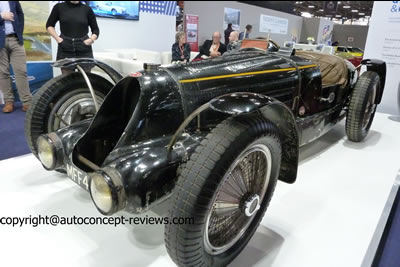 |
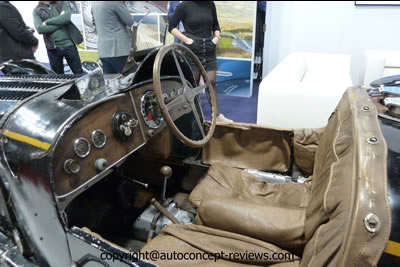 |
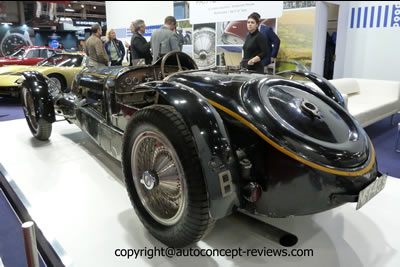 |
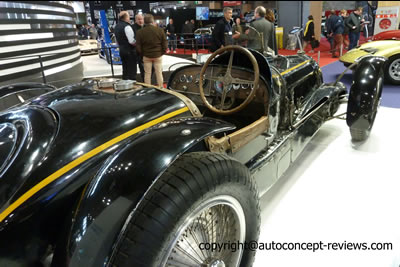 |
| |
1935 Renault Vivasport - Renault Classic
|
| Renault started the designation Viva in 1927. It was associated with a six cylinder engine. The designation evolved to Vivastella and ,starting in 1933, Vivasport. The Renault Vivastella is proposed either in coupe coachwork or convertible. The magazine Vie Automobile tested the car between Sevre and Bayonne, that is 724 km at an average speed of 100 kph (62 mph). The Renault Vivasport is propelled by a 3.665 cc 80 hp six cylinder engine operated through a three-speed gearbox. The weight 1800 kg, while the lenght is 4,76 m and width 1,75 m. |
|
1935 Scuderia Ferrari Alfa Romeo SF48 Bimotore- Lukas Huni |
The year 1934 marked the domination of racing through German technological might in the form of Mercedes Benz and Auto Union Grand Prix cars, made possible by the unlimited government financing and the ability to create new and lighter composite metals allowing to increase the displacement size of their engines upwards of 4000 cc. Gone was the dominance by France and Italy as the traditional elite of race car manufacture.
Alfa Romeo was desparate to regain their superiority. Scuderia Ferrari was tasked by Alfa Romeo to build their own supercar under the new Formula Libre- effectively lifting all weight and power restrictions. Long time Ferrari Technical Director Luigi Bazzi was not known for half measures. With a team of 30 employees at Scuderia Ferrari, Bazzi designed the Bimotore based on the Tipo B, featuring two Tipo B engines of 3165 cc that were placed in front and behind the driver with the rear engine facing to the rear. The differential was located in the middle with the power from both engines supplied to the rear wheels through twin driveshafts. The fuel tanks were placed on each side of the car for weight distribution. The performance with 540 hp from the two engines was enormous and surpassed both the Mercedes Benz and the Auto Union at 430 hp and 375 hp respectively. Two cars were built in total.
The Bimotore was intendedfor the fast tracks of the Formula Libre calendar, and the task was to compete with the large-engine competitors from Germany and France. Tough Alfa Romeo had access to several excellent drivers (René Dreyfus, Louis Chiron, etc) Enzo Ferrari knew only one driver could rise to this challenge- Great Mantuan Tazio Nuvolari. There was a rumor that Benito Mussolini himself intervened to persuade Nuvolari to leave Maserati and come back to Alfa Romeo.
Two Bimotore were entered for the 1935 Tripoli Grand Prix with Nuvolari and Chiron. While Caracciola and Fagioli shot into the lead. Nuvolari was able to pass Fagioli only to have to pit on the third lap for new rear tires. By race end Nuvolari would claim fourth followed by Chiron in a race won by Caracciola. Two weeks later at the Avus race in Berlin, Chiron conquered second place after Nuvolari did not finish due to constant shredding of his tires. In June 1935 Nuvolari set a land speed record on the Firenze-Lucca highway, his top speed on the second run exceeding 362 kilometer per hour.
Unfortunately, the breath taking performance in a straight line came at the high price of high weight (1300 kg), difficult handling with tire shredding causing frequent pit stops, as well as high fuel consumption. The Bimotore was not successful. One of the Bimotore was scrapped, the only remaining one was sold to British amateur driver Auston Dobson who raced the car in various British events including Brooklands and Donington, it later joined Tom Wheatcroft's Donington Collection. Today the Bimotore resides in a European collection. |
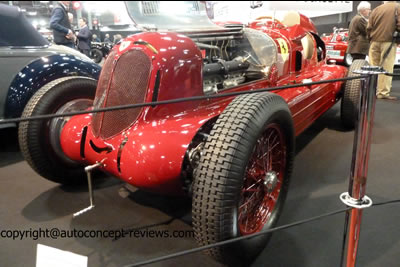 |
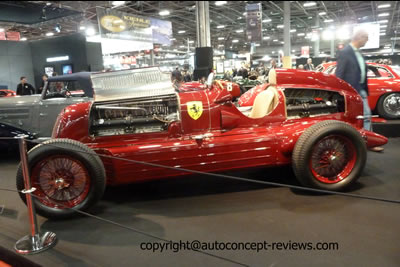 |
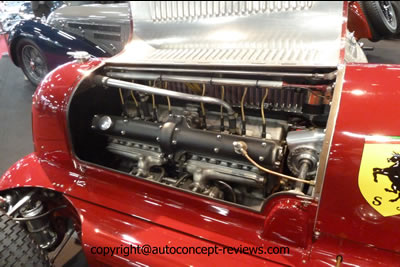 |
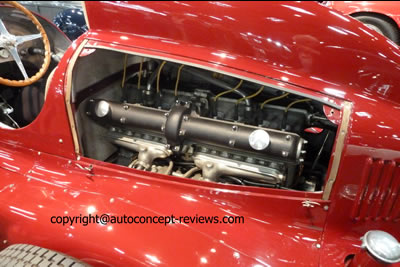 |
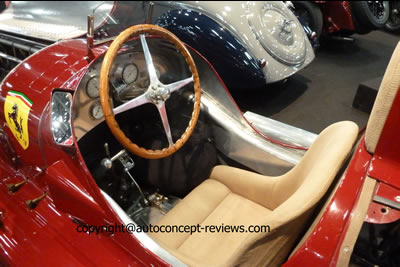 |
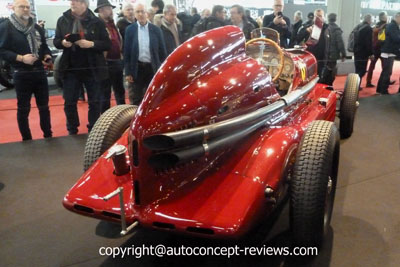 |
| |
1935-1939 Delahaye 135S Competition by Pourtout - Classic Le Mans |
| |
Delahaye first cars were built in 1895 designed throughout by Emile Delahaye. Emile Delahaye became racing driver and took part in some of the great town-to-town events. Delahaye's main business was commercial vehicles and fire engines with a reputation to be robust and reliable. A few cars were also produced; In 1934, Delahayes management decided for a drastic change and launched the 135 model line. A six cylinder engined chassis was proposed with engine capacity of 3. 557 cc. The purpose of the 135 was to change the image of the company and enter the market of prestigious saloon and sporst cars. Some of the most famous coachbuilders, like Chapron or Figoni & Falashi, have provided some "classic" cars.
see Delahaye 135 S Competition Pourtout 1935-1939 |
|
| |
1937 Mercedes Benz 540 K Cabriolet A Sindelfingen - RM Sotheby |
The manufacturing record of the 540 K reveals its exclusive nature: 97 being produced in 1936, 145 in 1937, 95 in 1938 and 69 in 1939. The magnificent Mercedes-Benz 540K represented the pinnacle of the pre-war achievements by the Stuttgart firm during the 1930s. A development of the 500K, whose independently suspended chassis it shared, the 540K was powered by a 5.4-litre supercharged straight-eight engine.
5,401cc OHV Inline 8-cylinder Engine with Roots Supercharger
180bhp at 3400rpm With Blower Engaged
4-Speed Manual Transmission
4-Wheel Independent Suspension
4-Wheel Drum Brakes
see Mercedes Benz 540K Special Roadster 1939 |
|
| |
1938 Peugeot Berline 202 - Peugeot Aventure
|
| The coachwork of the Peugeot 202 was designed by the stylist Henri Thomas with an aerodynamic style called 'fuseau Sochaux' that was a great contribution to the commercial success of this automobile. The Peugeot 202 sedan introduced in 1938 was propelled by a 1.133 cc engine giving up to 30 cv with overhead valves, removable cylinder sleeves and Alpax cylinder head. The transmission used a three speed gearbox with traction on the rear wheels. Between 1938 and 1949 104.126 Peugeot 202 in several versions have been produced with interruption during world war II. |
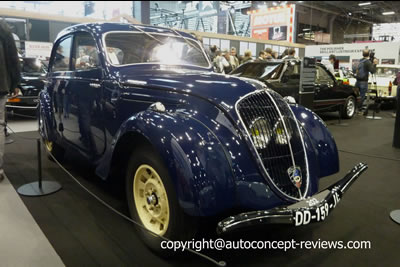 |
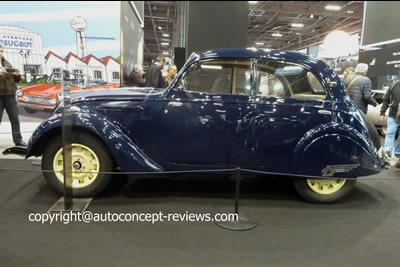 |
|
| |
1938 Rosengart Sutosix Super Sept Electric Coupe transformed in electric propulsion during 1940 - FFVE |
|
In view of the scarcity of petroleum supply during world war II, Lucien Rosengart who had obtained the license to produce Austin Seven in France decided to develop a Electrilux electric version . The conversion of a gasoline engine version into an electric version required two hours. There was an extreme price difference with 21.900 French Franc for the gasoline version and 53.000 French Franc for the Electrilux. It is not known how many cars were converted to electric propulsion. |
| |
1939 Delage D6 3 Litre - 2nd overall Le Mans 24 Hours- Delage Exhibit
|
The Delage D6 3 Litre driven by Louis Gerard and Georges Monneret was leading by two laps the Le Mans 24 Hours one hour before the finish of the race. A sudden broken valve spring handed the race to the Bugatti and the Delage finished second overall.
Louis Delage and Walter Watney had been desapointed by the lack of success of their 4.5 Litre V12 racing project during the 1937-1938 season and they decided to develop a new racing car derived from the Delage D6. Two chassis were built and were sent to coachbuilder Olivier Lecanu-Deschamps for an aluminium body. A cowled radiator and a fairing covered the front suspension, into which the lights were recessed. Aerodynamically shaped cycle wings were added. The specification of the straight six engine included an aluminium alloy cylinder head, modified inlet and exhaust manifolds and three Solex carburettors. In this form the engine produced 125 bhp at 4000 rpm linked to a Cotal gearbox. During testing at Monthlery the Delage reached 130 mph (210 kph).
(source Quentin Spurring- The official history of Le Mans 1930-39 ) |
|
| |
1939 Alfa Romeo 6C 2500 Sport Cabriolet by Touring - Anna Lisa Collection |
Debuting at the 1925 Milan Auto Show, the Alfa Romeo six cylinder 6C 1500 set the standard for lightweight, high performance road car and was followed in 1929 by the 6C 1750. The next evolution of the 6Ccame in 1934, and although traditional in its layout, the 6C 2300 had nearly twice the displacementof the car it succeeded. Accordingly, it was a highly competent automobile capable of providing excellent performance with multi passenger coachwork.
In 1939, the 6C 2300 was replaced by the 6C 2500. This change was completed by an increase in the cylinder bore of two millimetres, as well as an improved cylinder head for better aspiration and increased compression from 6,5:1 to 7,11:1. In the sport configuration this translated inti a respectable 95 hp with performance aided by lightweight aluminium coachwork.
There was 86 models built in 1939 its first production year.
In 2016, one 1939 Alfa Romeo 6C 2500 Sport Cabriolet by Touring was sold for £ 952.000 at RM London Auction Sale. (source RM Sotheby) |
|
| |
1941 Peugeot VLV with electric propulsion - Peugeot Aventure |
Petrol scarcity during Second World War induced Peugeot to produce the VLV ( Vehicle Leger de Ville or Light Urban Vehicle) with two seats. Weight 350 kg of which 160 kg are for the batteries. Operating range 80 km. Top speed 36 kph. 377 cars produced. These vehicles were essentially used for Post distribution or medical assistance since war conditions required special driving authorisation.
see Peugeot VLV electric 1941 1945 |
|
| |
1942 CGE-Tudor electric car by J.A. Gregoire - FFVE
|
J.A. Gregoire (1899-1992) is a Polytechnic engineer widely involved in the development of automobile. He developed a front wheel drive Tracta with which he participated in the 24 Hours of Le Mans. He developed an aluminium chassis for the Hotchkiss Gregoire before participating in the development of the electric CGE Tudor with the Compagnie Generale d'Electricité (CGE), l'Aluminium Français Gregoire (soon to become Pechiney), the automaker Hotchkis and the Societé des Batteries Tudor (Tudor batteries producer). The electric CGE Tudor was produced at 200 examples at a war time when petroleum supply was scarce. Two models were produced, a standard version with 400 kg batteries proposing 163 km range at average speed 41 kph and a record verions with 720 kg batteries proposing 250 km range at average speed of 42 kph. |
| |
|
1948 Lago Talbot T26C - Fiskens
|
This car chassis N°110002 is the second example of Antony Lago's legendary 4.5 Litre monopostos. Competed extensively in European Grand Prix driven by Ralph, Chaboud, Mairesse, Chiron and Etancelin.
see related article Talbot T26 GS le Mans 1950 - 1951 |
|
| |
1948 Jaguar Mk IV 3.5 Convertible - Cecil Cars
|
The Jaguar MkIV 3.5 Liter is the continuation of the production of the SS after World War II with a new name Jaguar. With a powerful 125 hp inline six cylinder , the 3.5 Litre DHC has a top speed of 91 mph. The engine was linked to a five-speed manual transmission. The car was equipped with four-wheel mechanical drum brakes. There was a solid front axle and rear live axle with semi elliptic springs front and rear. An interior awash in polished walnut and Conolly leather made the Jaguar a more attractive option for the money over anything on either side of the pond. William Lyons opened a sales network in the U.S. and one of the first sixteen cars sold overseas went to actor Clark Gable.
This car is one of only 376 3.5 Liter built for export market with left hand steering wheel.
One 1948 Jaguar 3.5 Liter Mk IV drophead coupe was sold for US$ 110.000 at RM Sotheby Auction Sale in Monterey California in 2011. (source RM Sotheby 2011) |
|
1950 Ferrari 166 MM Berlinetta Touring - TRADEX |
Count Giannino Marzotto bought the Ferrari 166MM from Enzo Ferrari. Touring provided it with an aerodynamic coupé body in Touring Superleggera construction. The car had been presented at the 1950 Geneva Motor Show, and Count Marzotto's aim was to drive it to victory in the 1950 Mille Miglia.
He was not happy with the output of the 166MM, however, and so Ferrari provided him with a new V12 Type 195 Colombo engine. This proved a resounding success: Count Marzotto and co-driver Marco Corsaro in car N° 724 swept to victory in the 1950 Mille Miglia. Sporting the spurs of this challenging "1.000 mile race", the Ferrari was exhibited at the Turin Motor Show that immediately followed.
see
Ferrari 166 MM 1949 Touring |
|
| |
1951 Ferrari 212 Export Coupe Vignale - Lukas Huni |
| One of only 8 ever produced 212 exports with factory supplied berlinetta body designed by Vignale. The car was acquired by Mr. C Wilke who is considered as the first person in the United States to collect Ferraris. Related article Car Review Ferrari 212 Export Vignale Berlinetta 1951. related review : Ferrari 212 Export Vignale Berlinetta 1951 |
|
| |
1952 Ferrari 342 America Pinin Farina Special Coupe - Haman Classic Cars
|
Ferrari wasted no time in exploring the potential of Lampredi's successful, Grand Prix, 'long-block' V12 engine as a road-going power unit, introducing the 340 America at the Paris Salon in October 1950, just a few months after its 4.1-litre engine's race debut. Just 23 of these competition-inspired 'big bangers' would be produced before production ceased in 1952.
Its successor, the 342 America, was conceived from the outset as a pure road car. More robust and better equipped than the lighter, competition-orientated 340 America, the '342' boasted a 9" longer wheelbase and a four-speed all-synchromesh gearbox. It retained its predecessor's Lampredi-designed, 4,101cc, two-cam V12 engine which, in '342' configuration, produced 200bhp at 5,000rpm. Just six 342 Americas were made in 1952/53. All but the first of the series, a Vignale cabriolet on chassis number '0232AL', were bodied by Pinin Farina, two as cabriolets and three as coupés, each of these hand-built cars being a unique creation to individual customer order as was the practice at the time.
One 1952 Ferrari 342 America Coupe Special by Pinin Farina was sold for US$ 632.500 at 2012 Arizona RM Sotheby Auction Sale . Source RM Sotheby 2012 and Bonhams 2003. |
|
| |
1952 Fiat OttoVu - Ruoto da Sogno
|
| The Fiat 8V was first presented at the Geneva Motor Show 1952 as a high performance 2-seater aerodynamic coupé. The name derives from the 8 cylinder vee-form engine developed by famous Fiat engineer Dante Giacosa. The V angle was set at 70 degree for a compact arrangement. The engine was positioned just behind the front axle which make the Fiat 8V a front mid-engine sports car ensuring an optimized weight distribution. see FIAT 8V 1952-1954 |
|
| |
1953 Ferrari 250 MM Berlinetta Pinin Farina ex-Noblet - Kidston |
The Ferrari 250 Mille Miglia was tailor-made to compete in frontline long-distance races, following upon the success of the pioneering 3-litre V12-engined 250S Coupe driven by Giovanni Bracco in the 1952 edition of the round-Italy thousand-mile road race. At the 1952 Paris Salon de l'Automobile exhibition, Ferrari showed a more conventional chassis for the new modello 250 3-litre V12-cylinder engine, for which the artistry of Carrozzeria Pinin Farina then created two-seat closed-cabin bodywork with aggressive 'potato-chipper' nose-grille treatment, a muscular, tucked-down tail and panoramic rear window – the defining Ferrari Berlinetta form. The new model was launched at the 1953 Geneva Salon as the Ferrari 250 MM (for Mille Miglia).
It was based upon a longer-wheelbase chassis than the 250 S at 2420 mm (95.3 in), with the Berlinetta version some 50 kg (110 lb) heavier than the sister 850 kg (1,874 lb) open-cockpit Barchetta which accompanied it. The V12 engine's dry sump was omitted for the production car, and four-speed transmission was adopted instead of five-speed. Power output increased to 237bhp (177 kW; 240 PS).
In 2014 at Quail Lodge California a Ferrari 250 MM Berlinetta previously owned by racing driver Phil Hill was sold fo US$ 7.260.000 at Bonhams Auction Sale.
Source - Bonhams 2014 - see also Ferrari 250 MM Berlinetta Pinin Farina 1953 |
|
| |
1953 Jaguar C Type - FISKENS
|
Few sports-racing cars have achieved such legendary status as the Jaguar C-Type, which won the 24 Hours of Le Mans twice for Coventry during the company’s domination of the event in the 1950s. The C-Type began life as the famed XK120 roadster, which had taken the world by storm in 1948 with its revolutionary dual overhead-cam engine.
Initially known as the XK120C (C for competition), the C-Type debuted at Le Mans in 1951 with a team of factory-sponsored cars. While two of the three entries were forced to retire early with oil line issues, the car driven by Peter Walker and Peter Whitehead took the overall victory—the first British car to win Le Mans in nearly 20 years.
220 bhp, 3,442 cc DOHC inline six-cylinder engine with three Weber carburetors, four-speed fully synchronized manual transmission, independent front suspension with upper and lower wishbones, torsion bars, and hydraulic dampers, live rear axle with trailing arms, ‘double-action’ torsion bar, and torque reaction member with hydraulic dampers, and four-wheel hydraulic disc brakes. Wheelbase: 96 in.
In 2015, one Jaguar C Type was sold for US$ 13.200.000 at RM Sotheby Auction Sale in Monterey California. It was Chassis N°052 that is one of three lightweight Works Team car and finished 4th overall at Le Mans in 1953.
(source RM Sotheby) |
|
| |
1954 Alfa Romeo 2000 Sportiva Prototype - Lukas Huni Exhibit |
At Portello, Alfa Romeo Company Director Orazio Satta Puliga and Development Head Giuseppe Basso marked the beginning of Assembly Line Production and monocoque technique. In addition to the basic 1900 model, Alfa Romeo planned a limited series of luxurious high speed cars that could be used on the road as in competition. Working with the leading "Carrozzieri of the time, and following the spectacular Disco Volante, Alfa Romeo engaged Bertone to design a Spider and a Berlinetta based on the 1900.
Franco Scaglione at Bertone created coachwork which was set to design trend throughout the Fifties, many features seen again in the later Giulietta and indeed the Tipo 33 Stradale. Named 2000 Sportiva 2 Spider versions were made, but the most fascinating variant was the closed Berlinetta variant of which 2 cars were made. Sophisticated technology with space frame guaranteed stability and a competitive weight (only 915 kg), and Scaglione combined favourable aerodynamics with uniquely beautiful lines. Technically the 1997 cc 4 cylinder twin cam engine with twin-choke Weber carburettors, dry sump lubrication and 138 hp, combined with a five speed transmission, double wishbone suspension, de Dion rear axle and inboard rear brakes provided excellent performance (top speed 220 kph) and handling. |
|
| |
1954 Alfa Romeo 1900 CSS Touring - Ruoto da Sogno
|
The Alfa Romeo's first all-new offering of the post-war period arrived in 1950. Designed by Dr Orazio Satta Puliga and intended for volume production, the 1900 was the first Alfa to employ unitary construction and - in keeping with the company's sporting heritage - was powered by a twin-overhead-camshaft engine. A four-cylinder unit, the latter displaced 1,884cc and produced 90bhp, an output sufficient to propel the four-door saloon to 93mph.
Launched in 1951, the 1900C Sprint featured bodywork by Pinin Farina (cabriolet) and Touring (coupé), both models utilising the 100bhp engine of the 1900TI sports saloon.
The final episode of the 1900 was the Super series, of which the Berlina, or saloon, and the 1900C Super Sprint were produced from 1953 to 1958. The Super series was mainly distinguished by the fact that the engine was enlarged raising capacity from 1,884cc to 1,975cc. 854 examples of the Alfa Romeo 1900 CSS Coupe Touring were produced.
In 2015, one 1954 Alfa Romeo 1900 CSS Coupe Touring was sold for Euros 176.426 at Bonhams Goodwood Auction Sale. In 2019, one 1954 Alfa Romeo 1900 CSS Coupe Touring was sold for Euros 230.000 at RM Sotheby Auction Sale in Paris.
(source Bonhams 2015-RM Sotheby 2019) |
|
| |
1954 Maserati A6GCS -53 - FISKENS
|
| The Maserati A6GCS-53 was a triumph from its dazzling debut in the 1947 season. The Maserati 2 Litre, 1.985 cc inline six was updated with acast aluminiumblock and overhead twin cam with dual plug ignition to produce 170 hp-gaining 50 hp on the A6GCM Grand Prix car from whence the engine came. Combined with the lightweight tubular chassis from Gilco , vast hydraulic drum brakes and drivers such as Ascari at the wheel, these spartan sports racers seemed unstoppable. Indeed, the successes of the Maserati A6CGS-53 provided such an economic bolster to Maserati, that it was able to make the transition from building purely racing machines to producing some of the most beautiful road going cars of the era. This Maserati A6GCS-53 was modified in period to longnose and with headrest. see also Maserati A6 GCS Barchetta Fantuzzi 1955 . |
|
| |
1957 Alfa Romeo Giulietta Sprint Veloce Zagato SVZ - Lukas Huni Exhibit |
Alfa Romeo had achieved its image of world's greatest Prewar car thanks to the 6C1750 Grand Sport of the Twenties and the 8C2300 of the Thirties, which won the 24 Hours of Le Mans no less than 4 times (1931,1932,1933,1934). After all had come to a halt during WW2, big efforts were made in the immediate Postwar years to resurrect the Prewar image of the marque. Winning the World Championship in 1950 (Farina onAlfetta 158) and 1951 (Fangio on Alfetta 159) gave an enormous boost to put Alfa Romeo on the map for the Fifties.
In addition to the very successful Giuletta production line (ultimately 17700 cars), the Alfa Romeo factory wanted to build an even more sporting model line aimed at its clients interested in ultimate preformance. The qualities of the standard Giulietta model (road holding, manoeuvrability, effective brakes, excellent engine , good comfort) were an excellent basis when in 1957 Alfa Romeo cooperated with Bertone to create the Sprint Speciale, featuring extravagant styling by Franco Scaglione, a sporty interior and 5-speed transmission, with a weight of 860 kg.
The constant aim for high performance, and the continuous interest by amateur drivers to participate in competition, kept the momentum at Alfa Romeo to support all efforts for that puyrpose. Coincidence helped when in 1956 the Carozzeria Zagato well known for lightweight constructions, was asked to rebody a client's Giuletta Sprint Veloce Coupé which had been seriously damaged in a road accident. Hence was created the Sprint Veloce Zagato, SVZ in short, featuring a sporting all aluminium lightweight, spartan but very beautiful Berlinetta- with complete absence of any luxury and minimal interior with Zagato lightweight seats- with a total weight of only 770 kg, nearly 100 kg lighter than anything before.
Instant success by the SVZ on racetracks, with a top speed of nearly 200 kph, demostrated the superiorityof this variant over the standard production cars. A fact that was not ignored by Alfa Romeo who as a result introduced the Zagato as an official model in 1961, called the Sprint Zagato (SZ) Coda Tonda (round rear end) - a slighly modified version of the SVZ. Seventeen example of the SVZ were produced.
In 2012, one 1958 Alfa Romeo Giulietta Sprint Veloce Zagato was sold for Euros 414.000 at RM Sotheby Auction in Monaco. |
|
|
1960 Aston Martin DB4 GT- Sports Classics Geneva London |
| The Aston Martin DB4 GT was developed as high performance version of the Aston Martin DB4. The DB4 GT was more suited for racing purpose. The DB4 GT is a two seat GT car while the DB4 was a 2+2 Grand Touring car. The wheelbase has been reduced by 12 cm compared to the DB4 and the engine is more powerful (about 300 hp). see Aston Martin DB4 GT 1960 |
|
| |
1961 Alfa Romeo Giuletta Sprint Zagato SZ Coda Tonda - Lukas Huni |
In addition to the very successful Giulietta production line (ultimately 177.000) cars), the Alfa Romeo factory wanted to buildan even more sporting model line aimed at its clients interested to ultimate performance. The qualities of the standard Giulietta model (road holding, manoeuvrability, effective brakes, excellent engine, good comfort) were an excellent basis when in 1957 Alfa Romeo cooperated with Bertone to create the Sprint Speciale, featuring extravagant styling by Franco Scaglione, a sporty interior and 5 speed transmission with a weight of 860 kg.
The constant aim for high performance, and the continuous interest by amateur drivers to participate in competition, kept the momentum at Alfa Romeo to support all efforts for that purpose. Coincidence helped when in 1956 the Carrozzeria Zagato, well known for lightweight constructions, was asked to rebody a client's Giulietta Sprint Veloce Coupe which had been seriously damagedin a road accident. Hence was created the Alfa Romeo Sprint Veloce Zagato -in short- SVZ, featuring a sporting all aluminium lightweight spartan but beautiful berlinetta- with complete absence of any luxury and a minimal interior with Zagato lightweight seats- with a total weight of only 785 kg.
Instant success by the SVZ on the racetracks, with a top speed of nearly 200 kph, demostrated the superiority of this variant over the standard production cars. A fact that was not ignored by Alfa Romeo who as a result introduced the Zagato as an official model in 1961, called the Alfa Romeo Sprint Zagato (SZ) Coda Tonda (round rear end), a slightly modified version of the SVZ. |
|
| |
1961 Ferrari 250 GT Passo Corto Competizione Berlinetta - Lukas Huni |
| The Ferrari 250 GT Berlinetta Passo Corto (in English world 250 GT Short Wheelbase ) built from 1960 until 1963 is considered by many the most exciting and most iconic sports car . 176 examples of the Ferrari 250 GT SWB were produced including steel body versions and aluminium body versions. The car exhibited here is one of the last 20 aluminium body 250 GT SWB -called Competizione cars that represent the last evolution of the Passo Corto Competizione, in many technical aspects very near the 250 GTO. The engines were further upgraded and the aluminium body featured even thinner aluminium. The car exhibited here was nicknamed SEFAC Hot Rod -Chassis Comp 168/61 SEFAC. see also Ferrari 250 GT SWB 1959-1962 |
|
| |
1961 Alfa Romeo Giuletta Sprint Veloce Tipo 101 coachwork by Bertone- Lukas Huni
|
Up until World War II, Alfa Romeo was considered a low volume manufacturer of extremely sporty and high quality cars targeted at an elite clientele. After World War II during which the Alfa Romeo plant was heavily bombarded and the European economy extremely weakened, the Milan based company found itself in difficulties finding buyers for their very sophisticated, hand crafted and expensive automobiles. Their first newly developed car the war was the Alfa Romeo 1900 which was first shown to the public in 1950. It was Alfa Romeo first car to be built on a production line which enabled them to produce a much higher number of cars.With the economy recovering only slowly, this relatively large and expensive automobile still struggled to find many buyers. The need for a smaller, less expensive car was desperately needed.
The Giulietta was developed to do just that, and the Giulietta Sprint (a beautiful coupé by Bertone) was first shown to the public at the Turin Motor Show in 1954. Shortly after followed the 4 door Giulietta Berlina and the breathtakingly beautiful Giulietta Spider designed by Pinin Farina. All Giulietta were powered by a highly sophisticated twin cam 1290cc 4 cylinder engine in various states of tune. Indeed, the Giuletta became a tremendous success, and with a total of nearly 177.000 produced vehicles it saved Alfa Romeo from bankrupcy. Only some 3058 examples of the Giulietta Sprint sporty Veloce version were produced between 1956 and 1962. The Veloce version variant distinguished itself through twin Weber carburettors, a higher compression ratio, different camshafts, a special high performance air intake box and a finned high performance oil sump. The result was 90 hpwhich, combined with a weight of a little over 890 kg, made it one of the fastest road cars of the Fifties (top speed 180 kph). In 1959 the 750E Giulietta was pgraded to the 101 Series Giulietta which included various small mechanical changes in favour of reliability a modernised front grille, larger taillights and some trim changes. |
|
| |
1961 Renault Floride - Renault Classic |
| The Renault Floride was a two seats convertible or coupe version of the Renault Dauphine with an exceptional body style designed by Pietro FRUA. The Floride was produced between 1958 and 1968 when 117.069 examples were completed. The car was called Caravelle on the U.S. market. |
|
| |
1962 Maserati 3500 GTi Coupe Touring - Tridente Classiche |
| The first Maserati 3500 GT was introduced at the 1957 Geneva Motor Show as a prototype with a Touring Coupé body (1962 Touring Coupe: photos 1/16 to 7/16). Production started in 1958 and lasted till 1964 for a total of 2.225 units including coupe and spider versions with different body; the great majority was Touring Superleggera coupe. Other body version were made by Allemeno, Frua or Vignale.The Maserati 3500 GT was designed by the engineer Alfieri using a multi-tubular space frame. See Maserati 3500 GT Coupé Touring & Spider Vignale 1958-1964 |
| |
| |
1962 Peugeot Berline 404 GT - Peugeot Aventure
|
| Introduced in 1960, the Peugeot 404 is commemorating its 60th anniversary. The car styling was designed by Pininfarina and differs drastically with the rounded body of the previous 403 model. The Peugeot 404 came with front coil spring damper system at the front. The engine is 1618 cc four cylinder engine mounted with an inclination of 45°. It was proposed with carburettor producing 72 hp and later (1962) with injection or Diesel version. The car was proposed as clutch-free with Jaeger torque converter or with a ZF automatic transmission. All versions included, 2.885.377 Peugeot 404 were produced of which 1.672.395 sedans between 1960 and 1979. |
|
|
1963 1968 ISO Grifo A3C and Bizzarini 5300 GT - Auto d'Epoca and ASCOTT |
| |
In 1963 the ISO Company introduced at the Turin Motor Show two new two seats short wheelbase coupes, the Iso Grifo A3L for Lusso and the Iso Grifo A3 C for Competition. Both cars presented specific body styles prepared once again by Carrozzeria Bertone with styling design by Giorgetto Giugiaro.
When Renzo Rivolta decided to discontinue the production of the A3 C, Giotto Bizzarini obtained the license to produce the car on its own under the designation of Bizzarini 5300 GT.
In the ISO Grifo A3C and Bizzarini 5300 GT the engine is placed in "front-mid-engine" position behind the front axle and so much back in the car that there is a trap on the dashboard to access the distributor. A dry sump lubrication system allows to place the engine in a low level improving the position of the centre of gravity and allowing a more streamlined body shape at the front.
see Iso Grifo A3 C and Bizzarini 5300 GT 1963 1968 |
|
| |
1964 Alfa Romeo Giulia Tubulare Zagato TZ1 - Lukas Huni
|
Following Alfa Romeo's tremendous success with the Giulietta model, development began on a suitable replacement - the Giulia. The more grown up model designation already hints that the twin cam 4 cylinder engine was enlarged from 1290 cc to 1570 cc which helped especially with higher low-end torque. The Milan based coachbuilder Zagato was Alfa Romeo's preferred partner when it came to the development of racing cars. Especially after the great sporting success with the Zagato built Giulietta SZ line, they were commissioned again to develop a competition version of the Giulia. The development for the Giulia TZ started already in 1959, well before the presentation of the new Giulia production model. In order to make the Giulia TZ with its small 4-cylinder engine match the much more powerful competitors (e.g. Ferrari) the TZ needed to have extremely low weight and good aerodynamics. Zagato therefore decided to build a tubular spaceframe chassis (hence the name TZ for Tubulare Zagato) with a streamlined body from extremely thin aluminium. The space frame alone weighed 62 kg and the total curb weight of the car was a mere 660 kg. This featherweight together with the highly sophisticated twin cam engine (developing 112 hp in street trim but up to 150 hp in race trim) made for an extremely successful racing car. Further technological highlights were all round disc brakes and independent suspension.
In order to homologate the Giulia TZ in the GT racing class, at least 100 units had to be produced and eventually 112 cars were made between 1964 and 1965. Since Alfa Romeo no longer had any factory involvement in racing, all cars left the Arese works in standard trim, but many were then taken to Conrero- an official Alfa Romeo race car preparer to make the cars even more suited for competition.
One 1965 Alfa Romeo Giulia TZ was sold for £ 254,500(€ 273,700) at 2008 Bonhams Auction Sale at Goodwood
One 1965 Alfa Romeo Giulia TZ was sold for Euros 955.440 at 2013 Artcurial Auction Sale at Retromobile event.
One 1965 Alfa Romeo Giulia TZ was sold for U.S.$ 1.023.000 at 2014 Gooding and Company Auction Sale at Pebble Beach California. |
|
| |
1964 CD Panhard LM 64 - GT LABEL
|
| Charles Deutsch and Rene Bonnet collaborated since 1936 to prepare racing cars under the designation D.B. In 1962 they separated when Rene Bonnet decided to work with Renault engines while Charles Deutsch continued with Panhard mechanical components; the company of Charles Deutsch was then designated CD. For the 1964 Le Mans 24 Hours edition Charles Deutsch and his team prepared a exceptionally aerodynamic racing coupe with supercharged Panhard engine at the front; equipped with two fins at the back the car completed a coefficient of 0,12 defined inwind tunnel. Two cars were entered for the 1964 Le Mans edition, with numbers 44 and 45. The car N°44 had engine trouble and could not finish while N°45 failed with transmission problems. During racing the cars demostrated the possibility with excellent aerodynamic and small engine to compete in performance with larger capacity contenders. The cars were equiped with flat bottom and covered wheels front and rear. |
|
| |
1965 Ferrari 275 GTS Cabriolet Pininfarina - Kidston
|
| At the 1964 Paris Motor Show Ferrari and Pininfarina introduced the 275 model line with 260 hp 3286 cc V12 engine. The Ferrari 275 line included a GTB closed berlinetta built by Scaglietti at Modena and a GTS open cabriolet produced at Pininfarina facility in Turin. The open GTS model was completely different in appearance and proportions to its closed berlinetta sibling. Only 200 examples of the 275 GTS were built over an 18 month period of production that is equal to less than half the quantity of the berlinetta GTB produced. |
|
| |
1966 4L BERTIN - Cite de l'Automobile
|
| This prototype was prepared by the French engineer Jean Bertin better known for his development work on aerotrain a train "flying" over a concrete rail moved by a giant air fan. He wanted to propose a small city car and prepared a shortened Renault 4L for urban traffic. The project was designated '4L Bertin'. |
|
| |
1966 Ferrari 275 GTB Competizione - FISKENS |
| A first in class and 3rd overall at the 1965 Le Mans 24 Hours race inspired Maranello to build twelve 275 GTB Competizione for the 1966 season. While outwardly similar to the road going example , the Competizione was lightened and mechanically revised wherever possible by Mauro Fohieri under whose guidance Ferrari won the driver's F1 World Championship title four times. This yellow 275 GTBc is only the third of twleve berlinetta Competizione to be produced at Maranello. The success story of this car include 10th overall and second in class at 1966 Le Mans 24 Hours where it was entered by Ecurie Francorchamp. It was absolute winner at 1966 Mont Ventoux Hill Climb driven by Lucien Bianchi. |
|
| |
1967 FERRARI P4 - Tradex
|
The Ferrari P4 is a development of the 1966 Ferrari P3. The Ferrari 330 P4 has a more powerful four litre 12 cylinder engine. The Ferrari 330 P4 completed a famous 1rst 2nd and 3rd postion at 1967 24 Hours of Daytona in the middle of the historic fight between Ferrari and Ford.
see Ferrari 330 P3 1966 |
|
| |
1967 Porsche 910 - ASCOTT
|
The Porsche 910 was prepared during 1966 as a development of the Porsche 906 intended for hillclimb events as well as long-distance races. The chassis is a multi-tubular unit lighter than the one of the Porsche 906 . The front track has been widened. The bodywork is sleeker and lower than the 906. The roof can be removed allowing for the choice between an open car or a coupé. The doors are hinged at their front edge and tilt forward for opening. The rear portion of the body can be pivoted toward the back while allowing full access to the engine and the transmission.
see Porsche 910 1967 |
|
| |
1968 McLaren M6GT - Richard Mille
|
Early on in McLaren’s history, company founder and racing driver Bruce McLaren set out to capitalise on the team’s success in the Can-Am series by building a racing car for the road. The McLaren M6 GT was Bruce’s pet project and he developed the car in-house at his Colnbrook factory near London during 1968/9. Only one prototype was made based on the dominant 1967 McLaren M6 chassis – a full monocoque tub made of aluminium alloy sheet over steel bulkheads. The engine was a 5.7 litre Ford unit producing around 370bhp and the chassis was clothed in an attractive coupé body made of reinforced polyester resin. The M6 GT’s dry weight of 725 kilos testifies that it really was a racing car for the road, rather than a civilised supercar.
Three examples were completed with this example propelled by 4942 cc 370 hp Chevrolet V8 engine. One example became Bruce McLaren personal car.
see McLaren M6 Gt 1968 |
|
| |
1969 Alfa Romeo Tipo 33-3 - RM Sotheby |
| This 1969 Alfa Romeo Tipo 33-3 will go under the hammer in Monaco and is an Autodelta factory team car with significant history on the grid Chassis N°105.80.023 raced at the 1970 Targa Florion where it was driven by Toine Hezemans and Masten Gregory. One month later, Nanni Galli and Rolf Stommelen ran as high as 2nd overall at the Le Mans 24 Hours. The estimated sales price is between Euros 2.200.000 and 2.600.000 by RM Sotheby Auction. see also Alfa Romeo 33-2-1968 as well as Alfa Romeo 33-2 Stradale 1967 |
|
| |
1969 Bertone Runabout Autobianchi A112 - ASI Bertone
|
| In 1969, Bertone used the Autobianchi A112's mechanics for an extravagant wedge shaped boat-like model, one of the first model of this range with headlights mounted at the height of the uprights and two shells from which it is composed. Reversing the mechanics of a modern car like the the front wheel drive A112 it served as a test bench for the Fiat X1/9. |
|
| |
1969 ISO Grifo Lusso 7 Litri Serie 1 by Bertone - MOVENDI
|
The Iso Grifo is a sports car built by the Italian automobile manufacturer Iso Rivolta from 1964 to 1974. The two-seater Iso Grifo-Coupé with a sporty design was conceived as a automobile in the Gran Turismo tradition for wealthy gentleman drivers. The coachwork of the ISO Grifo was designed by Giorgetto Giugiaro while working at Carrozzeria Bertone. Engineer Giotto Bizzarrini,a former employee of Ferrari , played a defining role in the development of the Grifo. Bizzarrini left Ferrari after a dispute and established his own design studio in Livorno in 1963.
see also ISO Grifo Can Am 1971. |
|
| |
1970 CITROEN GS 50th Anniversary - Citroen
|
The GS is a family car manufactured and marketed by Citroën for model years 1970-1986 in saloon and estate body styles (1970-1980), over a single generation. The GS received a facelift in 1979 and was subsequently marketed as the GSA in hatchback and estate bodystyles (1979-1986).
The GS was voted European Car of the Year for 1971 and was noted as technologically advanced, with class leading comfort, safety and aerodynamics.
The GS filled the gap in Citroën's range, between the 2CV and Ami economy cars and the luxurious DS executive sedan. The DS had moved significantly upmarket from its predecessor the Citroën Traction Avant, and beyond the finances of most French motorists. Leaving this market gap open for fifteen years allowed other manufacturers entry into the most profitable, high volume market segment in France.
The GS met with instant market acceptance and was the largest selling Citroën model for many years. 1,896,742 GS models and 576,757 GSA models were produced in total.
(source Wikipedia) |
|
| |
1970 1971 Citroen SM 50th Anniversary - 1971 Citroen SM Espace Heuliez - DS Heritage |
The Citroën SM is a high-performance coupé produced by the French manufacturer Citroën from 1970 to 1975. The SM placed third in the 1971 European Car of the Year contest, trailing its stablemate Citroën GS, and won the 1972 Motor Trend Car of the Year award in the U.S.
In 1961, Citroën began work on 'Project S' – a sports variant of the revolutionary Citroën DS. As was customary for the firm, many running concept vehicles were developed, increasingly complex and upmarket from the DS. At some stage in the 9-year project, it evolved from developing a faster variant of the 1955 DS to developing an entirely new, thoroughly engineered car – in terms of engineering effort, a replacement for the high volume DS model. Citroën purchased Maserati in 1968 with the intention of harnessing Maserati's high-performance engine technology to produce a true Gran Turismo car, combining the sophisticated Citroën suspension with a Maserati V6.
(source Wikipedia) |
|
| |
1971 Ferrari 365 GTB 4 N.A.R.T. - Movendi |
This example of Ferrari 365 GTB 4 was delivered directly to Chinetti Motors N.A.R.T. with works improved performance. This car participated at 1971 Sebring 12 Hours. This model was produced between 1968 and 1973. 1406 examples were produced including road and track versions. |
|
| |
1971 Maserati Bora 4.7 - Jorcar Automoveis Exhibit |
Introduced at the Geneva Motor Show in 1971, Maserati Bora quickly proved itself to be a compelling supercar alternative to a Ferrari, Lamborghini, Porsche or De Tomaso. It was the first Maserati road car with a mid-engine. Designed by Giorgetto Giugiaro at Ital Design, it was produced at 247 examples with left hand drive during 1971 to 1978. 564 Maserati Bora were produced from 1971 to 1980 including 4.9 versions.
Engineered by Giulio Alfieri (Maserati Race Car Engineer) and developed with a monocoque structure and four-wheel independent suspensions, hydraulic brakes, pop up headlamps, the Bora retains the requisite of the Italian Super-car, along with a healthy dose of comfort and luxury. 310 hp 4.719 cc V8 engine, 5-speed ZF transaxle; performance 0 to 100 kph (62 mph) in 6,7 seconds and a claimed top speed of 270 kph (167 mph).
One 1972 Maserati Bora 4.7 right hand drive was sold for £161.000 at 2018 RM London Auction Sale
One 1973 Maserati Bora 4.9 was sold for US$ 126.500 at 2016 RM Auction in Monterey California.
One 1973 Maserati Bora 4.9 was sold for US$ 179.200 at 2019 Bonhams Monterey California Auction sale. source RM 2016-2018, Bonhams 2019. |
|
| |
1971 Porsche 917 Long Tail - Classic Racing Car
|
The Porsche 917 is a sports prototype race car developed by German manufacturer Porsche. The 917 gave Porsche its first overall wins at the 24 Hours of Le Mans in 1970 and 1971. Powered by the Type 912 flat-12 engine of 4.5, 4.9, or 5 litres, the 917/30 Can-Am variant was capable of a 0-62 mph (100 km/h) time of 2.3 seconds, 0–124 mph (200 km/h) in 5.3 seconds, and a test track top speed of up to 240 mph (390 km/h).
On March 12, 1969, a 917 was displayed at the Geneva Motor Show, painted white with a green nose and a black No. 917. Brief literature on the car detailed a cash price of DM 140,000, approximately £16,000 at period exchange rates, or the price of about ten Porsche 911s. This price did not cover the costs of development.
The presence of the 512M "Sunoco", as well as the Alfa Romeo T33/3 which won Brands Hatch, the Targa Florio and Watkins Glen, forced Porsche to pursue their efforts in research and development: tails of the 917K and the 908/3 were modified with vertical fins, and the 917 LH aerodynamics received further improvements.
In 1971,Pedro Rodriquez had set a qualifying lap record of 3:13.9, setting him at pole position in his #18 John Wyer Gulf LH car that unfortunately did not finish the race [15]. Another LH car from the Martini team set a top speed record of 241mph before retiring due to engine failure. All in all, 4 separate Le Mans track records were broken that year: Fastest qualifying lap, fastest in-race lap, highest top speed, and longest distance covered. All were set by 917s.
(source Wikipedia)
see also Porsche 917 1969 1971 |
|
| |
1972 Citroen SM styled by Frua
|
Between 1970 and 1975 Carrozzeria FRUA came up with a new type of coachwork, initially aimed at at vehicles with a rear mid-engine , but once adjusted, it would later be just as suitable to use for dressing vehicles with yraditional mechanic layouts.
FRUA produced a very slim body, with a thin grille, pop-up headlightsand a side which, from the very top of the greenhouse down to the tail, was joined by a decorative element in metal plating with six slits which marked the end of the third volume box at the rear.
With the perspective of a possible artisan production of the model, it went by by the name Hispano Aleman Vizcaya and it was introduced to the public in Spring 1971. Only one example was produced.
The design of this agile berlinetta was later re-proposed, in a slightly larger size version as the Citroen SM, without any variations in styling having been provided in order to highlight the inverted position of the engine compared to the Hispano Aleman: the redefinition of the connexion between the greenhouse and the tail with a simple metal strip was the most visible element between the two models.
Two more coupe models were made starting from this base and similar styling, that is an Audi in 1974 and a BMW in 1976. (source Pietro Frua Maestro Designer - Libreria Automotoclub storico italiano Torino) |
|
| |
1972 Citroen Camargue by Bertone - ASI Bertone |
| Bertone made numerous prototypes on Citroen basis. One of these was the Camargue based on the Berlina GS; an elegant 2+2 hatchback with a sloping rear window, embelished by two glass bezels separated by a majextic roll bar. The front was instead complemented by a curved windscreen a typical feature of his models in those years. |
|
| |
1972 Lamborghini Miura SV Split Sump - Lukas Huni and 1973 Lamborghini Miura SVJ - Lamborghini Storico |
The Lamborghini Miura's first public appearance occurred at 1965 Turin Motor Show; there was only a steel monocoque chassis structure with operating components and that is quite unique a fact in car history.
The engine was from the Lamborghini 400 GT, a 4 litre V12 but it was mounted in transverse orientation just in front of the rear axle. This central position was intended to optimize the weight distribution. The 5 speed ZF gearbox was installed under the engine. The position of the engine transmission allowed for a small luggage compartment while maintained a limited overall length. Let us remember that, at the time, only British Motor Corporation adopted such a layout and it was for the Mini sedan launched in 1958 with a small four cylinder engine placed at the front end. The evolotion on the track has always been showing the trends for exclusive GT cars; endurance racing cars with gradual change from front engine rear wheel drive to rear engine rear wheel drive , illustrated by the Ford GT40, have certainly had a clear influence on the layout selected for the Lamborghini Miura.
see also Lamborghini Miura 1966 1972 --Lamborghini Miura SVJ 1972 -- Lamborghini Miura SV 1971 - |
|
| |
1974 MATRA SIMCA MS 670 B Le Mans 1974 Winner - Pescarolo Racing |
When Matra entered the automobile racing scene in 1965, its CEO Jean Luc Lagardere declared that his company will win in Formula One as well at Le Mans 24 Hours.
In 1972 Matra won Le Mans 24 Hours with Henri Pescarolo and Graham Hill at the wheel.
In 1974 in a fierce competition with Ferrari, the Matra 670B won with Henri Pescarolo and Gerard Larousse at the wheel. The Matra 670B was powered by a 2.993 cc 490 hp four overhead camshaft V12 engine. The weight was 675 kg and claimed top speed was 350 kph (217 mph) |
|
| |
1975 Lamborghini Urracco P300 -Eleven Cars
|
In the late 1960s, Ferrucio Lamborghini realized that his company required a competitive counterpoint to Porsche's 911 and Ferrari's Dino 246, and a less expensive alternative to the sensational Miura or the big Espada. Using a 2+2 configuration, offering rear seats that the rivals lacked, the car would also have a more powerful V8 engine, as well as being designed by Marcello Gandini and shaped by Bertone. Bob Wallace, the mechanical genius who had helped tune other Lamborghini suspension, had a hand in tweaking the four wheel independant McPherson strut suspension, which helped contribute to the Urraco's outstanding road holding.
The Lamborghini Urraco was first introduced at 1970 Turin Motor Show simultaneously on Bertone and Lamborghini exhibits. A Lamborghini P250 was produced in 520 units between 1973 and 1976 while the P300 was produced from 1973 to 1979 in 776 examples. Technical specification for the Urraco P300 are 265 hp 2.996 cc single overhead cam V8 engine transversally mounted with five speed manual transmission.
One 1976 Lamborghini Urraco P300 was sold for US$ 57.750 at 2013 RM Monterey Auction Sale (source RM 2013) |
|
| |
1976 Ferrari 308 GTB Rainbow by Bertone - ASI Bertone |
After the 308 GT4 model, previously made by Nuccio, Bertone threw himself into redesigning the same chassis. His endeavour resulted in the futuristic Rainbow, a model with a particular design: a roof which slid down behind the backrests of the rear seats. This model is compact and streamlined, very segmented, and deliberately disharmonious in some sections: it's perfectly clean cut and truly reminiscent of the past. The Rainbow remained a one-off design study. |
|
| |
1979 Ferrari 512 BB LM - Sport & Collection -500 Ferrari pour le Cancer
|
| In 1976 there was no Ferrari on the track for the Le Mans 24 Hours event. For the 1977 edition, the North American Racing Team (NART) of Luigi Chinetti entered a custom specially prepared Ferrari Ferrari 365 GT-4 Berlinetta Boxer finishing in 16th position. In 1978 Ferrari prepared with Pininfarina a factory prepared Ferrari 512 BB LM Competition Berlinetta intended for the 1979 racing season. see also Ferrari 512 BB LM Competition Berlinetta- Le Mans 1979 |
|
| |
1981 RONDEAU M 379C - Pescarolo Racing
|
Jean Rondeau developed the Inaltera Endurance racing car between 1976 and 1977. He then developed racing cars at his own name and finally won the 1980 Le Mans 24 Hours with the Rondeau M379. This car was further improved and became Rondeau M379C that was run at 2nd position by Henri Pescarolo and Patrick Tambay before the engine failed in 1981 event.
Engine DFL Cosworth V8 3300 cc producing 460 hp for a weight of 778 kg. Claimed top speed 350 kph (217 mph). |
|
| |
1983 BMW 635 Gr A - Seven Cars
|
The BMW 635 CSi Group A was homologated in response to Jaguar XJ-S contender. It was developed by specialist Alpina and Schnitzer and run by private team. In this case the car was run by Brumm Racing during 1984,1985,1986 seasons.
One 1983 BMW 635 CSi Group A was sold for Euros 297.500 at RM Monaco Auction Sale in 2018. source RM 2018 |
|
| |
1984 Chevrolet Corvette Ramarro by Bertone - ASI Bertone |
Carrozzeria Bertone has on several occasion presented design concept on American vehicles. The Corvette Ramarro Concept was introduced at the Los Angeles Motor Show in 1984. The project was based on the Corvette ZR1.
see Bertone Corvette Ramarro 1984 |
|
| |
1986 Citroen Zabrus by Bertone - ASI Bertone
|
| Based on the Citroen BX four wheel drive, Bertone created a modern hatchback with exclusive and sharp lines, offset by its wrap-around rear. Numerous stylistic elements from this model then appeared on the ZX, certainly not the extravagant upward-opening doors |
|
| |
1988 Lamborghini Genesis by Bertone - ASI Bertone
|
| For the last Lamborghini based dream car, Bertone choose to exaggerate the concept of a luxury station wagon with Genesis, a house on wheels, equipped with a 455 hp rear V12 engine. The front doors hinged in the middle of the roof, the two wide opening sliding rear doors and the modular interior were all especially stunning. In addition to its impressive grandiose appearance this model also boasted an enviable Cx. |
|
| |
1993 Maserati Barchetta - Tridente Classiche |
| This Maserati Barchetta was produced at 17 examples for a single model trophy event in Italy for two years. It is propelled by a 1996 cc 315 hp twin turbo V6 . The weight is 780 kg and claimed top speed is 300 kph (186 mph). |
|
| |
1995 Bugatti EB110 SS Le Mans - 100 Exhibit - 1995 Bugatti EB 110 Super Sport -Bugatti Exhibit |
In 1987 Romano Artioli, an Italian Ferrari distributor, decided to recreate the Bugatti car manufacturer. Bugatti was a famous automobile company founded by Ettore Bugatti and that produced luxury and sports racing cars from 1909 to 1947.
Romano Artioli acquired the right for the Bugatti name and prepared a new factory in Campogalliano in northern Italy. A team of specialists, including Ingeniere Paolo Stanzini and designer Marcello Gandini, was involved in the development of a new supercar.
see Bugatti EB 110 SS 1992 1995 |
|
| |
1995 McLaren F1 GTR at 24 Hours Le Mans - Richard Mille
|
The McLaren F1 was designed by Technical Director Gordon Murray for McLaren Cars. Gordon Murray had accumulated a long experience in designing formula one grand prix car when he strated this project of top performance supercar able to be driven everyday. Ultralight body and structure in carbon composite allows overall weight of 1120 kg.
At the request of several privare racing drivers McLaren prepared a GTR racing version that won 1995 Le Mans 24 Hours (car N°59 Ueno Clinic). The McLaren F1 GTR finished that event in 1st, 3rd, 4th , 5th and 13th overall position. The N°42 Art Car Team BBA finished 13th.
see McLaren F1 1994 |
|
| |
1997 McLaren F1 GTR LMGT1 Longtail Davidoff - Richard Mille
|
This Longtail version of the McLaren F1 GTR run by Gulf Team Davidoff McLaren finished 2nd in 1997 Le Mans 24 Hours race. Engine: 5990 cc 600 hp V12 by BMW
see McLaren F1 1994 |
|
| |
1998 Chrysler Viper GTS-R - Ascott
|
| This Chrysler Viper GTS-R obtained FIA GT2 World Champion in 1998. It participated with a Play Station livery at 1998 and 1999 24 Hours of Le Mans as well as 2002 and 2003 24 Hours of Spa. It has a steel tubular frame and carbon fiber composite body. The engine is 700 hp at 6800 rpm 7.986 cc V10 combined with a sequential 6 speed gearbox. Overall weight is 1150 kg. |
|
| |
1998 McLaren F1 Road car - Richard Mille
|
| The McLaren F1 is an exceptional sports car designed by Gordon Murray and produced between 1993 and 1998 by McLaren Cars at 71 homologated road cars, 28 racing prepared cars and 7 development prototypes. It is propelled by a specially prepared 60° 6.1 Litre 627 hp BMW V12 engine. see McLaren F1 1994 |
|
| |
1998 NISSAN R390 GT1 - 5th overall Le Mans 24 Hours - ASCOTT Collection
|
The Nissan R390 GT1 was a racing car built in Atsugi, Japan. It was designed primarily to gain a suitable racing entry in the 24 Hours of Le Mans in 1997 and 1998. It was built to race under the grand touring style rules, requiring a homologated road version to be built. Therefore, the R390 was built originally as road car, then a racing version of the car was developed afterwards. Only one R390 road car was ever built.
The NISSAN VRH35L twin-turbocharged V8 engine used in the R390 GT1.The engine produces 650 hp at 6.800 rpm and is linked to an XTRAC Sequential 6-speed gearbox. This car exhibired by Ascott Collection finished 5th at 1998 Le Mans 24 Hours. (source Wikipedia) |
|
| |
1998 Porsche 993 GT2 Art Car by Wolinski & Philippo - Mechanic Modern and Classic |
| This Porsche Art Car prepared by Wolinski and Philippo was driven by Laribiere, Poulain and Neugarten during the 1998 Le Mans 24 Hours. |
|
| |
2000 AUDI R8 LMP900-Chassis 405 - FISKENS
|
AUDI Chassis 405's first outing was with the Works Audi Sport Team Joest at the Le Mans Test in April where the R8 clocked the quickest time during the test. The AUDI Chassis 405 achieved a pole position , fastest lal and 2nd position overall in the 2000 Le Mans 24 Hours, driven by Alan Mc Nish, Stephane Ortelli and Laurent Aiello. After the Le Mans event, Audi Team Joest handed chassis 405 to Audi Sport North America.
Developed for the 2000 Le Mans 24 Hours, the new Audi R8 was designed in house by Wolfgang Appel and Michael Pfadenhauer. Built by Dallara, the R8 is powered by a 3,6 Litre V8 twin turbo unit producing 600 hp was very successful at Le Mans and in ALMS, scoring 1st and 2nd on the opening race at Sebring as well as 1st, 2nd and 3rd places in Le Mans event. |
|
| |
2001 Ferrari 550 GTS Prodrive -RM Sotheby and Ferrari 550 Maranello - FISKENS |
| The Ferrari 550 Maranello was first prepared by PRODRIVE for the GT1 racing category. Ferrari then commissioned Italtecnica to prepare an official racing version. |
|
| |
2007 Maserati MC12 Corsa - Girardot & Co.
|
In 2004, Maserati returned to top level motorsport, entering the FIA GT Championship with its MC12GT1. The car was an immediate success, and in only its second season , claimedthe FIA GT Manufacturer'sCup, scoring almost double the championship points of the nearest competitor.
The MC12 GT1 race car was powered by a 6.0 litre naturally aspirated V12 engine, which, due to regulations, was fitted with an air restrictor, resulting in an impressive 580 hp. Six FIA GT Championships, two FIA GT Constructors'Championship, six Drivers's Championships and no less than forty race victories followed.
MC12 Versione Corsa - Having witnessed such a domination, Maserati favoured clients were offered the opportunity to buy one of only twelve MC12 Versione Corsa. This car is a direct development of the MC12 GT1 and now void of air restrictors, the race-derived engine produced 745 hp at 8.000 rpm - more than 110 hp more than the MC12 Stradale and 150 hp more than the MC12 GT1 race car. |
|
| |
2010 Peugeot EX1 - Aventure Peugeot |
| Peugeot has etablished some historical records at Monthlery and decided for its 200 anniversary to run its EX1 Concept on the tract. The car with a 340 hp engine for a total dry weight of 750 kg driven by two 250 kW electric motors. Nicolas Vannier completed five records for the category of electric cars between 500 and 1000 kg. related car review : Peugeot EX1 |
|
| |
2013 Bugatti Veyron 16.4 Grand Sport Vitesse - Movendi Exhibit -and 2015 Bugatti Veyron 16.4 Grand Sport - Bugatti Exhibit |
Only 93 Bugatti Veyron 16.4 Grand Sport Vitesse have been produced. This 2013 example exhibited by Movendi has only 10.571 km since new and has the color scheme like the car used for the speed record for street legal car. see also 2010 Landspeed World record Bugatti Veyron 16.4 Super Sport - 431 kph (268 mph) as well as Bugatti Veyron 16.4 Grand Sport Vitesse 2013 Roadster World Speed Record
The blue car is Albert Spiess collection's 2015 Bugatti Veyron 16.4 Grand Sport Type 35 Edition exhibited by Bugatti. 8 Litre 4 turbo 1.001 hp 16 cylinder engine with 1250 Nm between 2200 and 5500 rpm. Top speed 407 kph (253mph). Standing start 0-100 kph (62 mph) in less than 2,7 seconds. Carbon fibre composite structure. |
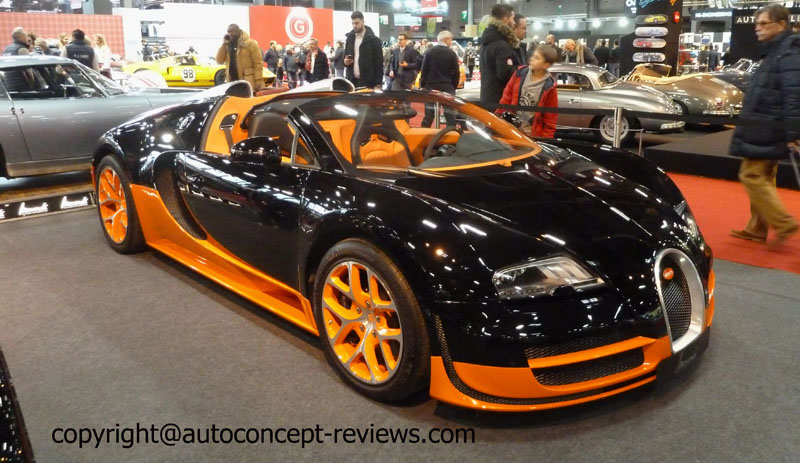 |
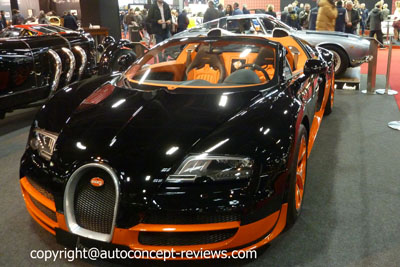 |
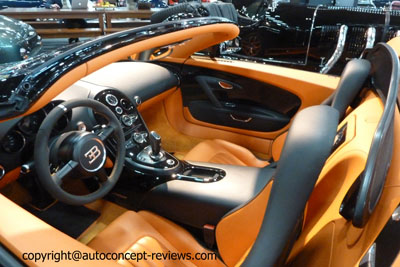 |
| 2013 Bugatti Veyron 16.4 Grand Sport Vitesse with color scheme similar to the street legal car of speed record |
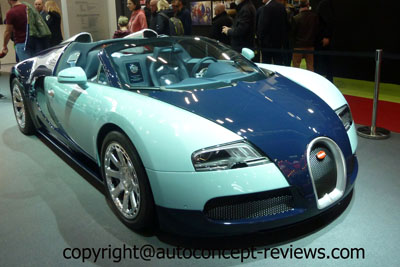 |
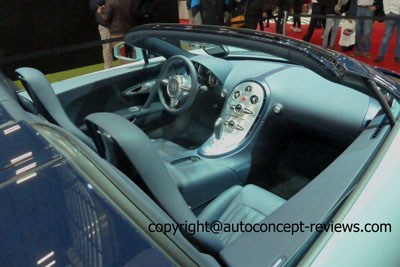 |
| 2015 Bugatti Veyron 16.4 Grand Sport Type 35 edition |
|
| |
2018 DS X E-Tense Concept - DS Heritage
|
In today’s fast-morphing automobile industry, the men and women at DS Automobiles were tasked with bringing to life their dreams for the car of tomorrow while sharing their automobile passion, uncurbed by predetermined constraints.
The fruit of that passionate, unfettered journey is DS X E-TENSE.*
Their vision for 2035 is very different from the current, near-obsessional quest for characterless mobility. Instead, the designers at DS sought to blend the benefits of advanced technology with a large measure of poetic creativity. Their answer explores how customers who have no qualms about indulging themselves and how they might perceive the notion of a luxurious French style eighteen years hence, however diverse their needs.
The cockpit is accessed by an Elytre door that is trimmed with a carbon fibre/leather weave. Inevitably, the eyes are drawn to the pyramidal architecture of the single seat, which adapts perfectly to the driver’s build like the fitted seats seen in motor racing, while its reclined position helps to keep the car’s centre of gravity low.
DS X E-TENSE’s asymmetric architecture provides distinct ambiences left and right. Climb into the cocoon part of the interior via the gullwing door and the driver, alone or accompanied, becomes a passenger. This asymmetric layout frees up a different type of space underneath the clear glass canopy, with the passenger enclosed in a sensuous capsule, snug in a ventilated. An additional seat even makes it possible to travel three-up.
Located within the front wheels, the two motors selected as the source of the all-electric DS X E-TENSE’s power provide unrivalled response. For road use, peak power stands at 400kW (540 horsepower), a figure that rises to 1,000kW (1,360 horsepower) in ‘circuit’ mode which allows the driver to savour the exquisite performance of the suspension engineered by DS Performance, the technical team behind DS’s Formula E programme. The carbon fibre chassis sits on innovative springs and torsion bars, while traction, grip and deceleration is controlled by an advanced active system conceived to optimise performance, whatever the type of road surface. |
|
| |
|
| |
2 - Artcurial Retromobile 2020 Auctions non exhaustive results
|
Artcurial dominated the week of collectors’ car sales in Paris this week, with ‘Retromobile 2020 by Artcurial Motorcars’, the official auction, realising close to 23M€ / 25M$. Some 70% of lots sold in the tenth edition of this unmissable international sale with something for everyone: stars, sport, history, originality and spectacle.
Collectors’ Automobiles were celebrated by Rétromobile and Artcurial Motorcars in the tenth edition of the Salon’s official auction, led by the trio Poulain, Lamoure and Novikoff. The sale realised a total of 22 894 104 € / 24 954 573 $.
This annual international event, a barometer for the collectors’ car market, continues to attract growing numbers of collectors and enthusiasts from around the world. With 18 nationalities represented, foreign buyers accounted for 81% of the total sales.
Artcurial Motorcars exhibited their expertise in this field by presenting a wonderful variety of vehicles, from the first mass-produced car - lot 44, the c. 1898 Benz Velociped Comfortable - to race-winning competition machines, and a line-up of rare and unusual vehicles. Five lots sold above 1M€, nine above 500 000 € and 47 above 100 000 €.
|
| |
1965 Ferrari 275 GTB 6 Carburettors Chassis 6785 sold for 2,502,800 € equivalent 2 753 831 US$
|
| The 1965 Ferrari 275 GTB #6785, delivered new to full race spec with 6 carburettors, has an impressive racing provenance. The car took part in over 40 international races between 1965 and 1968, including rally, track and hillclimb events. It featured on the cover of the Ferrari Yearbook in 1966, having won the GT class in the Monza 1000km that year. (source Artcurial) |
|
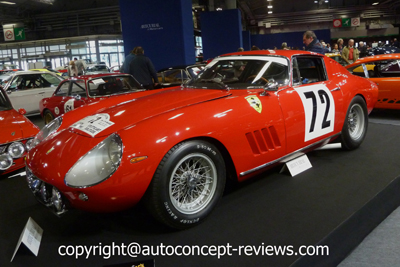 |
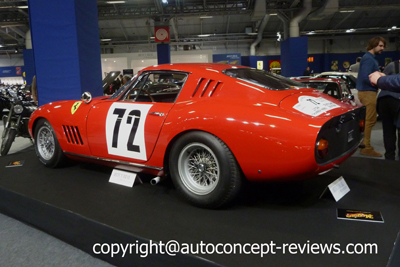 |
| |
1966 Porsche 906 sold for 1,730,600 € -
|
The Porsche 906 or Carrera 6 appeared in 1965 derived from a 904 with flat six engine. The new body was developped in wind tunnel. The chassis was tubular frame. Most models were propulsed by 2 liter flat 6
210 bhp, Type 901/20 1,991 cc SOHC air-cooled opposed six-cylinder engine with dual Weber 46IDA 3C triple-throat downdraft carburetors, five-speed manual transmission, independent front and rear suspension, and four-wheel disc brakes. Wheelbase: 90.6 in.
The 1966 Type 906, soon to be known by its more popular name of Carrera 6, was Porsche’s response to the 1965 appearance of Ferrari’s new featherweight hill climber, the 206 Dino. The Dino had rendered Porsche’s fiberglass-bodied 904 GTS obsolete almost overnight. Like the 904 and the Dino, the 906 had its engine mounted midship, which was ahead of the rear transaxle. Unlike the 904, which had been constructed on a sheet-steel backbone frame, the 906 was based on a light and very strong tubular steel space frame.
see Porsche 906 or Carrera 6 1966 – 1969 |
|
| |
1983 Ferrari 126C3-068-sold for 1 438 880 € equivalent 1 583 200 US$ |
The first Formula 1 Ferrari with a carbon fibre shell
Like McLaren, who were set to redefine F1 with their MP4 and its carbon fibre shell, Ferrari also decided to embrace this new technology with the brand new 126 C3. Unfortunately, they had quite a wait. Building a factory for construction of the carbon shell took longer than expected and the C3 made its first appearance in July 1983 at the British Grand Prix.
In the meantime, the 126 C2B, a modified version of the 126 C2, did more than act as an interim. Still a little too heavy, but equipped with a more reliable V6 Turbo engine that was 20bhp more powerful (580bhp), it made an impact at the start of the season in the hands of Patrick Tambay, when he won the Saint Marino Grand Prix. René Arnoux, the new recruit at Ferrari, took a little longer to find his form, although he managed two pole positions and two podium finishes early on.
The driving was amazing, and the arrival of the 126 C3 was an added bonus. Four chassis took part in the World Championship from July 1983: #066, #067, #068 (the car in the sale) and #069. With its lighter carbon/kevlar shell, the single-seater, designed by British engineer Harvey Postlethwaite, was also more powerful (600bhp), and was immediately on the pace. Proof of this came on its debut at Silverstone, the scene of the British Grand Prix on 16 July 1983. The two red cars claimed the front row of the grid, with Arnoux on pole. The car finished 2nd at GP Austria 1983, driven by René Arnoux - World Champion (source Artcurial) |
|
| |
1993 Jaguar XJ220 C Le Mans Chassis 003 sold for 1 085 760 € equivalent to 1 194 662 US$ |
The relationship between Tom Walkinshaw Racing and Jaguar dated back to the 1980s, when TWR successfully prepared the XJS for the World Touring Car Championship and the famous Group 44. In the process, it was thanks to TWR that Jaguar won the 24 Hours of Le Mans in 1988 and 1990, with its XJR-8 and XJR-12.
So when Jaguar introduced its XJ220 supercar, Walkinshaw lost no time in developing a competition version to compete in the GT category at Le Mans. The XJ220 C (for 'Competition') was produced in just eight months, for the 1993 24 Hours race. Among other changes, the car's weight was reduced with carbon fibre body parts, while the aerodynamics were improved to suit race conditions. The engine was the twin-turbo 3.5-litre V6 already used in the XJR-10 and XJR-11 prototypes: it was a proven unit, which could produce up to 800 bhp. For the XJ220 C, its output was limited to 500 to 680 bhp, depending on how it was used.
For Le Mans, TWR assembled three cars, with the chassis numbers 001 (race number 51), 002 (race number 50) and 003 (race number 52). 001 was assigned to Win Percy, Armin Hahne and David Leslie, 002 to David Brabham (Jack's son), John Nielsen and David Coulthard, and 003 to Paul Belmondo, Jay Cochran and Andreas Fuchs. It is chassis no. 003 which was offered for sale at this Artcurial Auction Sale.
This car participated in 1993 and 1995 Le Mans 24 Hours. (source Artcurial) |
|
| |
1936 Delahaye 135 Spécial two seats roadster 46625 sold for 917 840 € equivalent to 1 009 899 US$ |
This car is one of 16 genuine Delahaye 135 Specials built by the company. These competition models were designed to comply with the new ACF rules for sporting events, the most famous being Le Mans 24 Hours. Under these rules, a minimum production of 20 examples was required, and Delahaye developed two versions from the Type 135 : the 135 " Special ", for use by the factory and a few specially chosen clients and the less radical 135 " Competition Client " offered to private drivers. The car in exhibit here is indeed a " Special ", the rarest and most highly sought-after version. There were many modifications to the standard touring 135 version including : a shorter chassis (2.7m wheelbase), modified suspension, bigger brakes, lightweight alloy steering box, modified Type 103 engine with a displacement of 3 557cc which featured specific engine parts and competition distribution. With fantastic handling and reliability in endurance events, the Delahaye 135 succeeded at the highest level, securing victories in such prestigious races as the Le Mans 24 Hours and the Monte Carlo Rally. (source Artcurial) |
|
| |
1967 Serenissima MK 168 Prototipo sold for 899 960 € equivalent to 990 226 U.S.$ |
Last year, Serenissima and Count Volpi di Misurata made a remarkable reappearance, when Artcurial sold three cars built by the famous Italian aristocrat, team manager and constructor. In addition to these three automobiles that included the 1966 Le Mans spider, there are only two others known to have survived: the 1965 358V berlinetta and the prototype we are presenting here.
We must go back to 1965 to understand the history of this car, when Bruce McLaren decided to produce his own single seater Formula 1 car. He built the chassis with Robin Herd, but the Ford engine he'd selected turned out to be too big and heavy. Serenissima had a four-cam, dual ignition 3-litre V8 engine designed by Alberto Massimino (the former engineer for Alfa Romeo, Ferrari and Maserati). Although not designed specifically for competition, it was light and compact. Serenissima gave two such engines to McLaren who used them during the 1966 season in his first M2B F1 car, finishing 6th at Brands Hatch. The relationship between the New Zealander and the Italian team didn't end there as Count Volpi took delivery of a McLaren chassis from a CanAm prototype. Initially, he fitted this with his V8 Massimino engine. To differentiate it from the McLaren car, it was given a special fibreglass body. With a closed cockpit and doors hinged on the roof, the car had a fluid, elegant design, not unlike the Ferrari P2/P3 prototypes. In this form, the prototype was tested on the circuit at Modena by Giuliano Giuliani, chief mechanic for the Serenissima team, and British driver Jonathan Williams, who had been signed up by Nello Ugolini, former Ferrari team manager at Serenissima since the start of the 1960s. Williams remembered a car that was " very easy to drive ", and said that the testing had served to " sort out reliability problems with the engine ". He also mentioned " the happy atmosphere in this little team ".
Dressed in the Serenissima white livery, the car entered its first race on 15 August 1968, the Coppa Città di Enna, in Pergusa, Sicily. Along with the Porsche 910 of Jo Siffert, it proved to be quickest, and having qualified on the front row, the car finished in second place. However, having engaged Alf Francis, the former mechanic for Stirling Moss who had worked for Lotus, Count Volpi decided to modify the car for the 1969 season. To make the V8 Serenissima more competitive, Francis designed a cylinder head with three valves per cylinder. This was the engine used for the second version of the McLaren-Serenissima which was given a new body at the same time. Built in collaboration with Drogo using riveted " Avional " steel, it had a similar shape to the McLaren M8A CanAm. According to Count Volpi, Avional " was a very light but rigid steel. Hence the bodywork was very angular. "
As with all Serenissima cars, the aesthetics were appealing, but this wasn't enough to ensure success. According to Jonathan Williams, " the car was very pretty, but as soon as I sat behind the wheel I discovered a problem. It was extremely unstable at high speeds. " Various solutions were tested in an effort to rectify the problem. (source Artcurial) |
|
| |
1965 AC Cobra 289 roadster Chassis n° COB6027 sold for 750 960 € equivalent to 826 281 U.S.$ |
Cobra aficionados will know that the chassis numbers for these models provide an indication of their origin. If the number is preceded by " CSX " it is a Shelby Cobra, built in America. If, on the other hand, it starts with " COB " (CObra Britain), or " COX " (Cobra eXport), it is a car built in England by AC Cars, right-hand drive for the COB and left-hand drive for the COX. These versions, numbered from 6001 to 6062, are identical to the American cars, with 289 engines and Borg-Warner T10 gearboxes shipped over by Shelby American, but have an " AC Cars " badge on the boot rather than " Cobra " and " Powered by Ford ", perhaps thought to be an unnecessary detail for the Europeans
Between 1963 and 1966, AC built a total of just 61 examples, of which probably just over 20 were right-hand drive, a much smaller number than Shelby, who produced nearly 600 in the factory in Los Angeles. For the sake of completeness, we must add 27cars, both COB and COX, built by AC between 1966 and 1968 with coil spring suspension (as used in the 427 versions) and 289 engine. (source Artcurial) |
|
| |
2000 Lamborghini Diablo roadster VT sold for 214 560 € equivalent to 236 080 U.S.$ |
Launched in 1995, the roadster version of the Diablo was virtually a first for the make based on a V12 model, as the Miura roadster produced by Bertone had no successor. It is, moreover, much less common than the coupé, with total production of all series combined estimated at just 300 cars (versus more than 2000 for all models of the Diablo).
This example was proposed with 52.300 km completed by two owners. (source Artcurial) |
|
| |
1959 DB HBR4 Coach surbaissé " Le monstre " sold for 172 840 € equivalent to 190 176 U.S.$
|
Fast and extremely light, the D.B. Coach was a remarkably agile car in competition. At the time, the D.B. stood out in different disciplines in motorsport: in endurance racing, hill-climbs and, of course, in rallying. An experienced racing driver and Panhard agent in Chambéry, André Guilhaudin competed in a huge number of events at the wheel of special Panhards and Panhard-engined D.B's. Guilhaudin was convinced of the potential of the D.B. Coach and believed that a drastic programme of development would improve its performance still further. He therefore persuaded his friend, the racer Jacques-Edouard Rey, to order a new HBR4 Coach from D.B., to be modified in line with his ideas. Rey took delivery of the car in June 1959. Finished in a bright shade of blue, it was registered 765 CM 73 on 28 August 1959. Guilhaudin's project aimed to achieve the greatest possible weight-saving and a considerable improvement in the drag coefficient by reducing the frontal area.
The car was modified in accordance with his instructions by the Chalmette bodyshop in Grenoble. The first stage consisted in lowering the roofline by about 12cm (4.7in). Work to cut into the body continued by getting rid of the original windscreen frame and replacing it with a rear window frame from a Panhard Dyna Z1. The doors were formed from aluminium in a sweep extending the angle of the front section. For the brakes, Guilhaudin had some drums machined and modified by L'Aluminium Français, based on those fitted to production Panhards. They were fitted with extra cooling fins, making them similar, at least in terms of their appearance, to the Alfin models which would be used by D.B.
The modified Coach made its first appearance in competition in September in the Tour de France Automobile (no. 111). For this event, Guilhaudin & Rey had a 747cc engine. The car proved very quick and finished 8th overall, winning the Index of Performance in the GT category. On 11 October, the same crew took part in the Critérium des Cévennes, where they won their class and came 5th overall. The performance and the results achieved by this privately entered car inevitably came to the attention of René Bonnet. If certain accounts are to be believed, it was at this time, and within the D.B. team itself, that the car acquired its nickname of "The Monster". In the wake of this, Bonnet asked Jacques Hubert to develop a lowered version of the Coach, which led to ten or so cars being built.
The 1960 season opened with the Monte-Carlo Rally, in which the car competed as no. 4. Guilhaudin & Rey were forced to retire. On 5/6 March, the pair took part in the Lyon-Charbonnières Rally, and then, from 15-23 September in the Tour de France (no. 109), where they finished 4th in the Index of Performance in the GT category and 12th overall. "The Monster" made its début in endurance racing in the 1961 Le Mans 24 Hours race. It was fitted with an 848cc works engine prepared by D.B. A true featherweight, the car weighed in at just 559kg, split 367kg/192kg front-to-rear. A copy of the weighing records will be given to the buyer. Driven with gusto by Guilhaudin and Jean-François Jaeger, the car performed brilliantly, coming 2nd in the Index of Performance and 20th overall, after covering 3268.86km (2031.18 miles) at an average speed of 136.203kph (84.633mph). |
|
| |
1898 Benz Velociped Comfortable sold for 170 456 € equivalent to 187 553 U.S.$ |
Sold from 1894, the Benz 'Velo' marked a real milestone in automotive history, as it was the first car to go into series production. From 1898, a 'Comfortable' version was offered, which could transport four passengers, thanks to its solid axles with a wider track. The power developed by the single-cylinder Benz engine steadily increased, reaching 3.5 HP when production ended in 1902.
It is thought that the model presented, the famous 'Comfortable' version, was delivered new in Paris; then, when her parents died, its previous owner had it moved to her country house, to the north of Rennes. It was there, at the end of the 1930s, that Mr. Piel discovered it as he was cycling to his place of study. In 1953, when he had become an agent for Citroën, he went to see the owner, accompanied by the local priest to vouch for his good character. She agreed to sell it to him for 4000 francs, as the receipt dated 4 September which comes with the car confirms. She made him promise to keep the car forever, which he did, even when the Schlumpf brothers offered to swap it for a Mercedes 300 SL 'Gullwing' at the end of the 1960s! (source Artcurial)
see Benz Velo 1894 1902 |
|
| |
2003 Lamborghini Murciélago sold for 149 000 € equivalent to 163 945 U.S.$ |
The Murcielago is the first new Lamborghini developed under AUDI management. The 6.2 Litre V12 derived from the Diablo powertrain produces 580 hp. The Lamborghini Murcielago has all wheel drive powertrain. 3.066 examples shall be produced between 2002 and 2006.
This Murcielago, with 28.800 km from new, is in beautiful condition in its metallic grey paint, "Grigio Antares". Its black leather interior is in excellent shape as well. Its 6.2L V12 develops 580hp and is paired to a manual gearbox, allowing the car to exceed 330km/h with a generous torque. The car is fitted with a magnificent Bertoli exhaust system and second generation tail lights. |
|
| |
|








